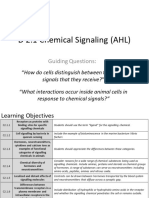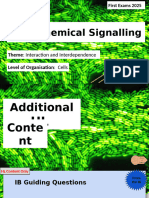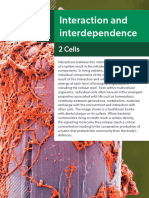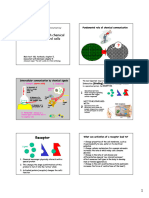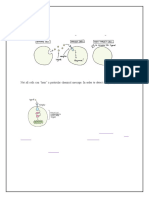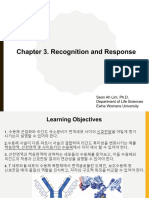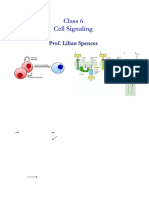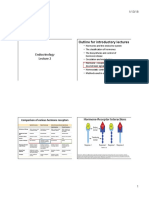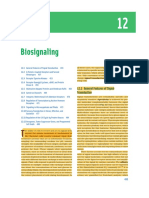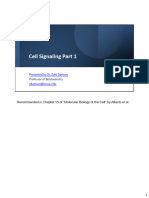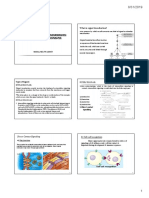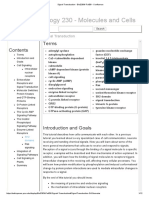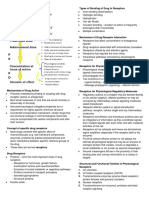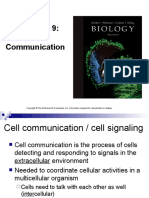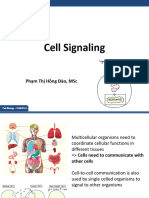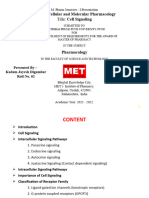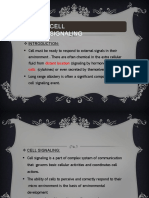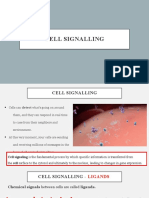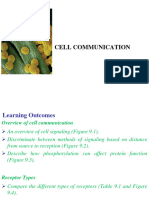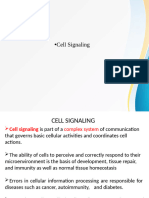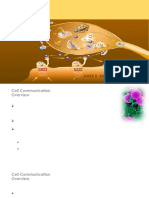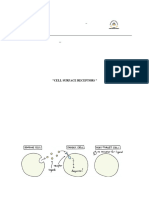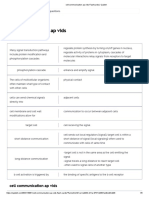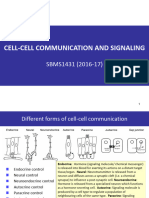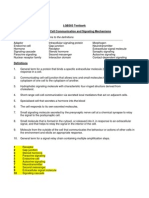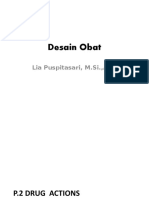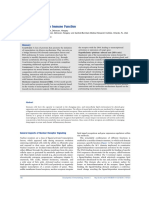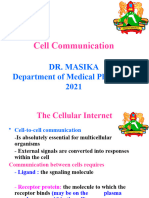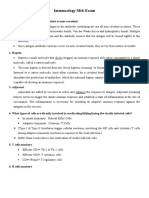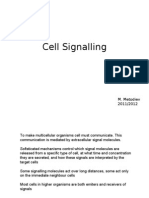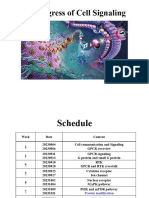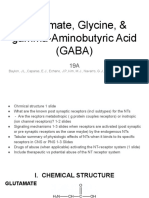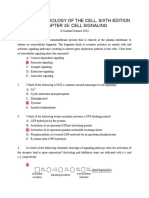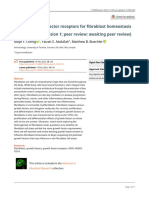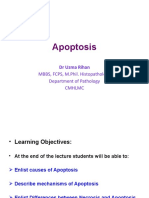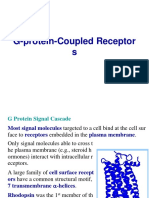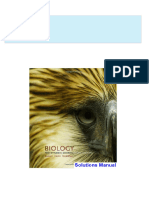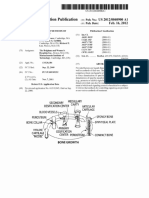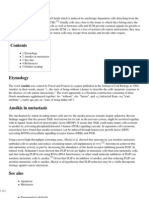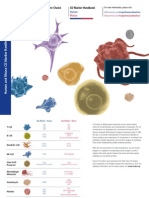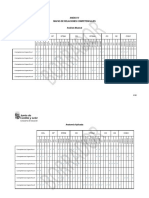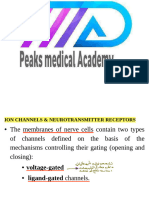Hodder
Hodder
Uploaded by
mittra.ancchalCopyright:
Available Formats
Hodder
Hodder
Uploaded by
mittra.ancchalCopyright
Available Formats
Share this document
Did you find this document useful?
Is this content inappropriate?
Copyright:
Available Formats
Hodder
Hodder
Uploaded by
mittra.ancchalCopyright:
Available Formats
C2.
1 Chemical signalling
HL ONLY
Guiding questions
• How do cells distinguish between the many signals that they receive?
• What interactions occur inside animal cells in response to chemical signals?
SYLLABUS CONTENT
This chapter covers the following syllabus content:
C2.1.1 Receptors as proteins with binding sites for specific signalling chemicals
(HL only)
C2.1.2 Cell signalling by bacteria in quorum sensing (HL only)
C2.1.3 Hormones, neurotransmitters, cytokines and calcium ions as examples of
functional categories of signalling chemicals in animals (HL only)
C2.1.4 Chemical diversity of hormones and neurotransmitters (HL only)
C2.1.5 Localized and distant effects of signalling molecules (HL only)
C2.1.6 Differences between transmembrane receptors in a plasma membrane and
intracellular receptors in the cytoplasm or nucleus (HL only)
C2.1.7 Initiation of signal transduction pathways by receptors (HL only)
C2.1.8 Transmembrane receptors for neurotransmitters and changes to membrane
potential (HL only)
C2.1.9 Transmembrane proteins that activate G protein (HL only)
C2.1.10 Mechanism of action of epinephrine (adrenaline) receptors (HL only)
◆ Ligand: general term
C2.1.11 Transmembrane receptors with tyrosine kinase activity (HL only)
for a molecule that binds
C2.1.12 Intracellular receptors that affect gene expression (HL only)
to a specific site on a
C2.1.13 Effects of the hormones oestradiol and progesterone on target cells (HL only)
protein.
C2.1.14 Regulation of cell signalling pathways by positive and negative feedback
◆ Chemical signalling: (HL only)
the release of chemicals
(ligands) that bind to a
specific molecule which
delivers a signal within
Receptors
the cell or to another cell.
Cells in a multicellular organism (and even bacteria) must respond to environmental stimuli and
◆ Receptor protein:
protein that recognizes
communicate with each other to coordinate their activities. This is done by specific chemical
and binds with a specific signalling molecules known as ligands. These ligands include proteins, small peptides, amino acids,
chemical signal molecule nucleotides, steroids, amines and even dissolved gases such as nitrogen monoxide (nitric oxide, NO).
on the outside of the
plasma membrane. The cell chemical signalling process ensures that important activities occur in the correct cells, at
the right time and in coordination with other cells in the organism. This usually involves a change in
gene transcription, which often affects several genes simultaneously, but not necessarily all to the
Top tip! same extent.
You should use the In most cases the ligand cannot cross the cell membrane and must bind with a receptor protein
term ‘ligand’ for (Figure C2.1.1). Receptor proteins are unique to specific ligands. The specificity of the ligand–
chemical signalling
receptor interaction allows a ligand to produce responses in specific target cells. Ligands can activate
molecules.
many different target cells simultaneously, which allows for the regulation and control of the cellular
response. The binding process transmits a signal across the membrane and generates a second
1 Define the term
protein or messenger inside the cell. This can cause further changes within the cell, such as
ligand.
activation of an enzyme, which often occurs via phosphorylation (addition of phosphate groups).
450 Theme C: Interaction and interdependence – Cells
364240_23_IB_Biology_3rd_Edn_C_21.indd 450 23/03/2023 22:08
Link In some cases, the messenger may enter the nucleus (via the nuclear pores) and change transcription
HL ONLY
Transcription is (copying of the genetic code on to messenger RNA). These processes are examples of
covered in detail signal transduction.
in Chapter D1.2,
page 615.
Common mistake
◆ Signal transduction: Do not confuse ‘receptor protein’ with the term ‘receptor’. Receptors are specialized cells that
the conversion of an receive stimuli, and change (transduce) this signal into an electrical impulse (see Chapter C2.2).
impulse or stimulus from Receptor proteins are molecules that bind with ligands to convey messages into a cell, stimulating
one physical or chemical specific metabolic reactions.
form to another. In cell
biology, the process by
which a cell responds to receptor
Receptor protein
protein
an extracellular signal. for attachment signal
of specific chemical
◆ Second messenger: signalling molecule message
small intracellular ligand – a signal is then generated
(signalling molecule) that is transmitted inside the
generated or released cell
■ Figure C2.1.1 Outline of
inside a cell in response to cellular chemical signalling
an extracellular signal. (signal transduction)
◆ Effector protein: A chemical signalling pathway has one or more critical functions:
proteins that cause a
l Relay (‘pass on’) the signal onward and help spread it through the cell.
change inside a cell
during signalling. l Amplify the signal received (via a second messenger), making it stronger, so that a small
◆ Scaffold protein: number of ligands are enough to produce a large intracellular response. One ligand can activate
protein that binds two many signal transduction pathways to trigger many cell reactions simultaneously.
or more other proteins,
l Detect signals from more than one intracellular chemical signalling pathway and integrate them
and organizes binding
partners into a functional (two or more signals become one signal) before relaying a signal onward.
unit to enhance signalling l Distribute the signal to more than one effector protein, creating branches and resulting in a
efficiency. complex response (Figure C2.1.2).
Primary transduction is when the ‘message’ converts from being extracellular (outside the cell)
to intracellular (inside the cell). The scaffold protein holds some proteins close together, so the
reaction is faster.
The same signal molecule can trigger different cellular responses in two different cells in the body.
2 Suggest why Because different types of differentiated cells activate different sets of genes, different kinds of cells
chemical signalling have different collections of proteins.
in multicellular
organisms is more Concept: Interdependence
complicated than
in single-celled Chemical signalling relies on many different molecules to pass along the signal,
all needing to work together to control cell metabolism and keep the organism
organisms, such
working properly.
as yeast.
ATL C2.1A
Before learning more about cell signalling in this chapter, find out about this topic yourself by
watching the animation at this website: https://dnalc.cshl.edu/resources/3d/cellsignals.html
The animation shows how a fibroblast cell responds to external signals after an injury.
What knowledge of biology already covered in the course does this topic draw on? What aspects
of cell structure, cell membranes and proteins do you need to know about to understand how
cells respond to external chemical signals?
C2.1 Chemical signalling 451
364240_23_IB_Biology_3rd_Edn_C_21.indd 451 23/03/2023 22:08
EXTRACELLULAR
ligand
HL ONLY
receptor protein
CYTOPLASM
scaffold
protein
relay
proteins
◆ Quorum sensing: adaptor
the ability of some protein
bacteria to monitor cell
density and to adjust their
gene expression.
amplifier and
transducer protein
low cell density
second messenger
integrator
protein anchoring
signal protein
molecules
bacteria modulator
cytoskeleton
protein
individual behaviours
messenger
high cell density protein
nuclear
envelope
RNA
target protein gene
transcription
DNA
target
NUCLEUS
group behaviours gene
■ Figure C2.1.3 Bacterial ■ Figure C2.1.2 Intracellular signalling proteins can relay, amplify, integrate and distribute the
quorum sensing incoming signal
Cell signalling by bacteria in quorum sensing
In the early days of microbiology, bacteria were considered non-social organisms that led individual
Top tip! lifestyles with little interaction. However, recent research has shown that many strains of bacteria
communicate with each other by emitting, detecting and responding to ligands. One important,
The size of the
well-studied method of intercellular communication, known as quorum sensing (Figure C2.1.3), allows
‘quorum’ is not fixed
but depends on the bacteria to turn on genes together in response to increases in the density of cells in the population.
rate of production Quorum sensing relies on the bacteria producing and releasing signal molecules that diffuse
and loss of the outwards from the bacterium. This allows the bacteria population to communicate with each other
signal molecules.
and coordinate their behaviour when a certain population size is reached.
452 Theme C: Interaction and interdependence – Cells
364240_23_IB_Biology_3rd_Edn_C_21.indd 452 23/03/2023 22:08
◆ Autoinducers: a Quorum sensing signalling molecules are often known as autoinducers. These are detected by
HL ONLY
signalling molecule specific proteins inside the cell or in the bacterial cell membrane. When the autoinducer binds to the
produced and used by receptor, it activates or represses transcription of target genes, which often include those for
bacteria participating in
autoinducer synthesis.
quorum sensing.
When the bacterial population is low, diffusion reduces the concentration of the autoinducer in the
surroundings to a very low value. As the population increases, the concentration of the autoinducer
reaches a threshold, gene expression occurs and more autoinducer is synthesized. This forms a
positive feedback loop for autoinducer production.
Link
Positive feedback loops are covered later in this chapter, page 465, in fruit ripening in
Chapter C3.1, page 516, and in hormonal control of pregnancy in Chapter D3.1, page 722.
A well-known example of quorum sensing is shown by the bioluminescent marine bacterium Vibrio
fischeri, which produces the light-emitting enzyme luciferase when it reaches a critical cell population
density in the light organ of its host, the squid (Figure C2.1.4). It is of little benefit to V. fischeri to
Link
produce luciferase when it is on its own as a single cell. The bacteria do not emit light when they are
Mutualism as
an interspecific
outside of the host. The bioluminescence is very energy intensive and so the bacteria benefits from
relationship is covered being located within the animal where it can obtain nutrients. The squid also benefits from having
in Chapter C4.1, the bacteria: the light the bacteria emit attracts prey or can be used as camouflage. This interaction is
page 565. known as mutualism.
Going further
Cystic fibrosis is a genetic disorder. The most common symptoms are difficulty in
breathing and excessive mucus production. This is due to frequent lung infections often
involving large colonies of the bacterium Pseudomonas aeruginosa, which are resistant
to antibiotics because they produce enzymes and a biofilm when the cell density
exceeds a critical value detected by quorum sensing. A biofilm is a complex aggregation
of micro-organisms marked by the excretion of a protective and adhesive extracellular
matrix. The production of the biofilm provides the organism with protection against
■ Figure C2.1.4 Image
of the Hawaiian antibiotics and the enzymes damage the lung epithelium.
bobtail squid showing
bioluminescence produced
by Vibrio fischeri
Signalling chemicals in animals
In animals, many ligands may be classified as hormones, neurotransmitters, cytokines or calcium ions.
3 Outline the role
of quorum sensing ■ Hormones
in bacteria.
Hormones are secreted by endocrine glands and are carried through the circulatory system to act
4 Define the term on distant target cells. Hormones act over a longer time, work in cell metabolism and other functions
hormone. e.g. sexual reproduction. Hormones are discussed further later in this chapter on page 454.
Link
■ Neurotransmitters
Neurotransmitters carry signals between neurons or from neurons to other types of target cells
Neurotransmitters
are also covered (such as muscle cells). The release of neurotransmitters is caused by the arrival of an action potential
in Chapter C2.2, at the end of a neuron. Neurotransmitters are discussed further later in this chapter on page 455.
page 476; human
hormones are covered ◆ Hormone: extracellular signal molecule that is secreted and transported via the bloodstream (in
in Chapter D3.1, animals) or the sap (in plants) to target tissues where it causes a specific effect.
page 693 and D3.3, ◆ Neurotransmitter: chemical released at the presynaptic membrane of an axon when an action
page 760. potential arrives, which transmits the action potential across the synapse.
C2.1 Chemical signalling 453
364240_23_IB_Biology_3rd_Edn_C_21.indd 453 23/03/2023 22:08
■ Cytokines
HL ONLY
◆ Cytokines: small The cytokines form a family of relatively small, secreted proteins that control many aspects of
signalling molecules growth and differentiation of specific types of cells. Some cytokines, such as a-interferon, are
(usually a protein or produced and secreted by many types of cells after infection with viruses.
glycoprotein) made and
secreted by cells that act
on neighbouring cells to ■ Calcium ions
alter their behaviour. Most ligands are organic, but some metal ions are involved in cells signalling, especially calcium
ions (Ca2+ (aq)). Many ligands in animals, including neurotransmitters, growth factors and some
Top tip! hormones, induce responses in their target cells via signal transduction pathways that increase the
concentration of Ca2+ (aq) in the cytoplasm.
Note that some
neurotransmitters Increasing the cytoplasmic concentration of Ca2+ (aq) causes a number of responses in animal
can also act as cells, including muscle cell contraction, secretion of substances (for example, the neurotransmitter
hormones. For acetylcholine) and cell division.
example, epinephrine
Although cells always contain calcium ions, this ion can function as a second messenger because its
(adrenaline)
functions both as
concentration in the cytoplasm is normally much lower than the concentration outside the cell.
a neurotransmitter
and as a hormone
produced by the Chemical diversity of hormones
adrenal gland to signal
glycogen breakdown in
and neurotransmitters
muscle cells.
A wide range of extracellular molecules and ions can act as ligands for receptor proteins in cell
signalling pathways. They include metal ions, low molar mass compounds (for example, amino acids
and molecules derived from them), steroids, peptides and proteins.
■ Hormones
There are three main classes of hormone (Table C2.1.1): proteins (such as insulin), amines (also
known as amino acid derivatives, such as epinephrine) and steroids (such as cholesterol, which is
needed to synthesize oestradiol and testosterone). Hormones can be small, non-polar, hydrophobic
molecules that diffuse through the cell membrane to reach receptors in the nucleus or cytoplasm.
Examples are progesterone and testosterone, as well as thyroid hormones.
■ Table C2.1.1 Three main chemical classes of hormones
Hormone Protein/peptide
class hormones Steroid hormones Amine hormones
Example Insulin Oestradiol Epinephrine (adrenaline)
OH OH
H 2N
Phe
Val
H
Leu Ala
Tyr Glu
Asn
Gln CH3
HO N
Val
Leu His
Leu
Val
Leu
Gly Cys
CH3
His
Glu Cys
Arg S Ser
H 2N
Gly
S S
Gly Gly
COOH Asn S
Cys
Phe Tyr lle
HO
Cys
Phe Asn
Val Gln Cys Thr
Glu
Glu S
Tyr Ser
Leu S
Thr lle
Gln Cys
Pro Tyr Leu Ser
Lys
Thr
COOH
HO
Hormones can also be water-soluble molecules that bind to receptors on the plasma membrane.
They are either proteins like insulin and glucagon, or small, charged molecules like histamine
and epinephrine.
454 Theme C: Interaction and interdependence – Cells
364240_23_IB_Biology_3rd_Edn_C_21.indd 454 23/03/2023 22:08
Nature
■ Neurotransmitters
HL ONLY
of science: Neurotransmitters are a chemically diverse group of chemicals, including simple amines (for
Experiments example, dopamine), amino acids (for example, gamma-aminobutyric acid or GABA), polypeptides
(for example, endorphins) and acetylcholine (an amino acid derivative).
Evidence for the role
Although some neurons produce and release only one kind of neurotransmitter, most make
of nitric oxide (NO) in
causing the relaxation
two or more and may release one or more at any given time. The coexistence of more than one
of smooth muscle neurotransmitter in the synapse makes it possible for the cell to exert several influences at the
came from a set of same time.
experiments in which In the brain and other parts of the central nervous system, the gas nitric oxide (NO) functions as a
the neurotransmitter
neurotransmitter, or as an agent that influences neurotransmitters.
acetylcholine was
added to experimental
preparations of Concept: Interaction
the smooth muscle
cells that surround Neurotransmitters interact with the synapse to convey messages through the body.
blood vessels. The Several neurotransmitters in the same synapse allow a number of messages to be passed
direct application of on at the same time, and so allow varied responses to stimuli.
acetylcholine to these
cells caused them to
contract, the expected Going further
effect of acetylcholine
on these muscle cells.
Nitric oxide and cell signalling
However, addition
of acetylcholine to Nitric oxide (nitrogen monoxide, NO) gas molecules can rapidly diffuse across the
the lumen of small, plasma membrane into the cytoplasm of target cells and directly control the activity of
isolated blood vessels specific intracellular proteins. Nitric oxide is synthesized from the amino acid arginine
in culture medium and diffuses from its site of synthesis into nearby cells. The gas only acts locally because
caused the underlying it is quickly converted to a range of products by reacting with oxygen and water
smooth muscles to outside cells.
relax, not contract.
Later studies showed
Nitric oxide causes the smooth muscle in blood vessels to relax, causing the blood
that, in response to vessel to dilate (widen), increasing blood flow. Many nerve cells also use NO to signal
acetylcholine, the neighbouring cells.
endothelial cells that
line the lumen of blood
vessels were releasing
a substance (later
shown to be NO) that
Localized and distant effects
triggered muscle cell of signalling molecules
relaxation.
Cells in multicellular organisms usually communicate via ligands targeted for cells that may be either
adjacent (local chemical signalling) or not adjacent (long-distance chemical signalling).
◆ Synaptic signalling:
a type of cell–cell
communication that ■ Local chemical signalling
occurs across chemical Local signalling involves direct contact between cells. Neurons are separated by synapses. Synaptic
synapses in the
signalling occurs across chemical synapses and involves neurotransmitters such as acetylcholine
nervous system.
and norepinephrine. The gap between the presynaptic membrane and the postsynaptic membrane is
very small, between 20 and 40 nanometres (nm). Neurotransmitters therefore only have to transfer
Link
the signal over a small distance. While the immediate effect of the neurotransmitter is localized, the
Neurons and synapses
are covered in detail overall effect is widespread because the signal transmitted across the synapse enables an electrical
in Chapter C2.2, impulse to be established in the postsynaptic neuron and the message is transferred on through
page 467. the body.
C2.1 Chemical signalling 455
364240_23_IB_Biology_3rd_Edn_C_21.indd 455 23/03/2023 22:08
◆ Ligand-gated One of the main neurotransmitters in the human body is acetylcholine. On reaching the postsynaptic
HL ONLY
channel: an ion channel membrane, acetylcholine binds with the neurotransmitter receptors (ligand-gated sodium channels)
that is stimulated to found on the postsynaptic membrane, causing the opening of ion channels. This results in the influx
open by the binding of a
small molecule such as a of sodium ions, Na+ (aq), which generates a new impulse in the postsynaptic neuron.
neurotransmitter. Other examples of local chemical signalling include gap junctions in animals and plasmodesmata in
◆ Ion channel: plants. In animals, cells may communicate between membrane-bound molecules on the cell surface
transmembrane protein
membrane (cell–cell recognition).
that forms a pore across
the bilayer through
which specific ions
Link
can diffuse down their Gap junctions are discussed in Chapter B2.1, page 243. Plasmodesmata are discussed in
concentration gradients. Chapter B3.2, page 306.
Top tip! ■ Long-distance chemical signalling
For long-distance signalling, hormones are secreted into the transport system (for example, the
Neurons releasing
blood plasma of an animal or the sap of a plant) to act on distant target cells. In animals with a
acetylcholine
are described as closed circulation system (i.e. heart, arteries, veins and capillaries – see Figure B3.2.22, page 315),
cholinergic neurons, hormones are transported in the blood, and so can travel throughout the body to receptors that are
while those releasing very far away from the source. The hormones are specific to receptor proteins either in the plasma
norepinephrine are membrane or within the cell (see below). The hormones trigger a cascade of reactions, which leads to
described as adrenergic
the target cell altering its metabolism to respond to the signal.
neurons.
Specialized animal cells release hormone molecules (for example, insulin and glucagon) into blood
Link vessels of the circulatory system to other parts of the body, where they reach target cells that can
The endocrine system recognize and respond to the hormones. This is known as endocrine signalling.
is covered in Chapter Plant hormones (for example, auxin, a growth hormone) sometimes travel in the vascular tissue but
C3.1, page 493.
often reach their targets by moving through cells or by diffusion through the air as a gas.
Top tip!
The same ligand can
Differences between transmembrane
bind to different and intracellular receptors
receptor proteins
causing different Receptor proteins can either be in the plasma membrane (transmembrane) or within the cytoplasm
responses (for example, (intracellular) (see Figure C2.1.5). The properties of a ligand determine the type of receptor that is
acetylcholine). On used. Some ligands are non-polar and therefore lipid-soluble, whereas others are charged and water-
the other hand,
soluble. Non-polar ligands can diffuse through the phospholipid bilayer and access receptor proteins
different ligands
within the cell. Polar ligands, such as peptide hormones (e.g. insulin and glucagon) are hydrophilic
binding to different
receptor proteins can and cannot pass through the phospholipid bilayer. These ligands must bind with receptor proteins
produce the same on the surface of the cell.
cellular response (for
a lipid-insoluble ligand b lipid-soluble ligand
example, glucagon and
epinephrine). target cell
target cell
receptor protein
receptor product protein synthesis
■ Figure C2.1.5 Lipid-
protein
insoluble ligands utilize
receptor proteins in activated enzyme
the plasma membrane, ligand–receptor
or other protein DNA
whereas lipid-soluble complex
ligands can diffuse
through the membrane mRNA
and access intracellular secondary messengers nucleus
protein receptors
456 Theme C: Interaction and interdependence – Cells
364240_23_IB_Biology_3rd_Edn_C_21.indd 456 23/03/2023 22:08
Common mistake
HL ONLY
◆ Transmembrane
receptor protein: cell
It is incorrect to say that all receptor proteins are in the plasma membrane. The receptors on the
signalling receptor protein
that is in the membrane. surface of the cell respond to charged, polar ligands. Ligands that are lipid soluble, such as steroid
◆ Intracellular hormones, can pass through the phospholipid bilayer and so their receptors are inside the cell.
receptor protein: cell
signalling receptor protein Corresponding to the two classes of signal molecules there are, therefore, two classes of receptor
located inside the cell. proteins: transmembrane receptor proteins and intracellular receptor proteins.
■ Transmembrane receptor proteins
In Chapter B1.2, we saw how R-groups determine the properties of assembled polypeptides.
R-groups are hydrophobic or hydrophilic, with hydrophilic R-groups being polar or charged, acidic
or basic. Transmembrane receptor proteins have three different regions: a ligand-binding region, a
Top tip! hydrophobic region extending through the membrane, and an intracellular region that transmits
The number of cell- the signal to the inside of the cell. Integral proteins, including receptor proteins, have regions with
surface receptors hydrophobic amino acids, helping them to embed in membranes. Hydrophilic regions of the receptor
may be regulated by proteins are towards the outside of the membrane where the phosphate heads of the phospholipids
endocytosis to reduce are located. Hydrophilic ligands bind to the hydrophilic region of the receptor protein.
their number. They
may also be inactivated
In most cases, ligands bind to a receptor in the plasma membrane of the responding cell. This
by phosphorylation. interaction produces a change in the shape of the receptor that causes the signal to be relayed across
the membrane to the receptor’s cytoplasm. This is the process of cell transduction.
There are many different receptors in the plasma membrane of cells and they can be classified into a
small number of structural classes. They are covered later in this chapter.
Top tip!
Ion channels are
Nature of science: Experiments
necessary to transport
ions into and out of
Identification of cell-surface receptors
a cell because ions
are charged particles Hormone receptors are difficult to identify and purify (usually with chromatography) because they
(surrounded by polar are present in very low numbers, and they have to be solubilized with non-ionic detergents. Because
water molecules) of their high specificity and high affinity for binding with their ligands, the presence of a certain
and therefore cannot receptor in a cell can be detected and quantified by measuring their binding to radioactively labelled
diffuse across the hormones. The binding of the hormone to a cell suspension increases with hormone concentration
hydrophobic interior of until it reaches receptor saturation. Specific binding is obtained by measuring both the total and the
the plasma membrane. non-specific binding (which is obtained by using a large excess of unlabelled hormone).
■ Intracellular receptor proteins
Many lipid-soluble ligands diffuse across the plasma membrane, diffuse into the nucleus, bind to the
DNA and initiate specific protein synthesis, which then initiates reactions (Figure C2.1.6). Steroid
hormones such as oestradiol, progesterone and testosterone are examples of this type of ligand.
Steroid receptors
Steroid receptors are not present in the membrane but are normally present as soluble proteins in the
Link cytoplasm. Since steroid hormones are lipid soluble, they diffuse from the bloodstream across the
Transcription is hydrophobic plasma membrane into the cytoplasm of cells. If the cell is a target cell, the hormone
covered in Chapter binds to a receptor molecule, which may be present in the cytoplasm or may be within the nucleus.
D1.2, page 615 and
genes are covered If the receptor is in the cytoplasm, it moves to the nucleus by simple diffusion. In either case, if the
in Chapter D2.2, receptor molecule is activated, it acts as transcription factor by binding to specific regions of DNA in
page 670. the chromosomes (see Chapters D1.1 and D1.2).
C2.1 Chemical signalling 457
364240_23_IB_Biology_3rd_Edn_C_21.indd 457 23/03/2023 22:08
Depending on a hormone’s mode of action, transcription
steroid
HL ONLY
hormone
of a gene may be switched on or switched off. If a gene
has been activated, new RNA is formed, leaves the
blood in
capillary nucleus and then directs the formation of new proteins
(most likely an enzyme) at ribosomes. The new protein
moves through
membrane by diffusion
or enzyme will bring about a structural or functional
change in the cell. Of course, if a gene is switched off by
steroid
receptor hormone action, some cell process will be interrupted
in cytoplasm or terminated.
gene structure/
activated function
to yield
mRNA
of cell
altered
Initiation of signal
transduction pathways
by receptors
For a cell to respond when it encounters a signal, the
activated
enzyme ligand must first be recognized by a specific receptor
molecule on the plasma membrane and then transmitted
to the cell’s interior before a cellular response can occur.
mRNA to
ribosomes in Cell signalling can be divided into three stages:
cytoplasm
1 Ligand–receptor interaction
2 Signal transduction
■ Figure C2.1.6 The mechanism of
action of a lipid-soluble hormone 3 Cellular response.
■ 1 Ligand–receptor interaction
5 Compare The ligand is complementary in shape to a binding site on the receptor and binds to it. There is
and contrast high specificity in the ligand–receptor binding. The binding of the ligand to the receptor activates
transmembrane the receptor.
and intracellular
receptor proteins.
■ 2 Signal transduction
The signal transduction pathway often requires a sequence of changes in a series of different
◆ Signal cascade: series molecules in a multistep pathway. These molecules in the pathway are often called relay molecules.
of linked reactions, often Signal transduction occurs via two main ways: protein phosphorylation in a phosphorylation signal
including phosphorylation
cascade and the release of second messengers, for example cyclic AMP (see Figures C2.1.2 and
and dephosphorylation,
that carries information C2.1.13). Such pathways also allow for signal amplification.
within a cell, often The activated receptor activates a relay molecule, which activates another relay molecule, and so
amplifying an initial signal.
on, until the molecule (usually a protein) that produces the final cellular response is activated.
◆ Phosphorylation
cascade: a sequence
Many of the relay molecules in signal transduction pathways are protein kinases and they often
of events where one act on other protein kinases in the pathway. Each activated protein kinase will initiate a sequential
protein kinase enzyme phosphorylation and activation of other kinases, resulting in a phosphorylation cascade.
phosphorylates another,
causing a sequence of Relay molecules are usually activated when they are phosphorylated, and deactivated when they
events that leads to the are dephosphorylated. The processes of phosphorylation and dephosphorylation act as a molecular
phosphorylation of many switch in the cell, turning metabolic activities on and off as required.
protein kinases. As the
signal is carried onwards
it is amplified and
■ 3 Cellular response
sometimes can spread to The signal transduction pathway leads to a specific cellular response, which is the regulation of one
other signalling pathways. or more cellular activities. The response may occur in the nucleus or the cytoplasm of a cell.
458 Theme C: Interaction and interdependence – Cells
364240_23_IB_Biology_3rd_Edn_C_21.indd 458 23/03/2023 22:08
◆ Apoptosis: a form of Depending on the type of cell and ligand, some cellular responses may include:
HL ONLY
programmed cell death l regulation of activity of protein (for example, the opening or closing of an ion channel in the
that allows cells that are plasma membrane changes the membrane permeability)
unneeded or unwanted
l regulation of protein synthesis by activating or deactivating specific gene expression by turning
to be eliminated from
an adult or developing genes on or off in the nucleus
organism. l regulation of the activity of an enzyme
l rearrangement of the cytoskeleton of the cell
l death of the cell (for example, apoptosis).
After the specific cellular response has occurred, the signal is terminated. The ability of a cell to
receive new ligands depends on the reversibility of the changes produced by previous signals.
Link
The role of sodium
Transmembrane receptors for neurotransmitters
ion channels is
discussed in Chapter
and changes to membrane potential
B2.1, page 239 and
The ligand-gated sodium ion channel (Figure C2.1.7) is composed of five transmembrane protein
their role in changing
membrane potential subunits. The protein subunits combine to form an aqueous pore across the lipid bilayer, which
is covered in C2.2, is lined by five transmembrane a-helices, one from each subunit. There are two acetylcholine
page 479. binding sites.
ACh Na+
nicotinic receptor
Going further
Curare
Curare (a plant
alkaloid) causes
muscle paralysis by
blocking excitatory
■ Figure C2.1.7 The open and closed conformations of the
acetylcholine acetylcholine receptor (ligand-gated sodium channels)
receptors at the
When acetylcholine released by a motor neuron binds to both acetylcholine binding sites, the
neuromuscular
channel undergoes a change in conformation (shape): the hydrophobic side chains move apart and
junction. It is used
by surgeons to relax the gate opens, allowing sodium ions to flow across the membrane down their electrochemical
muscles during and concentration gradient. This depolarizes the plasma membrane (Figure C2.2.4, page 471) and
an operation. changes the membrane potential (the voltage across the membrane), which leads to other changes
(see Chapter C2.2, page 467).
◆ GTP: guanosine
triphosphate with a role
Transmembrane receptors
in cell signalling. that activate G protein
◆ G protein: a
membrane-bound GTP is an energy-rich nucleotide like ATP, composed of ribose and three phosphate groups but with
GTP binding protein, guanine rather than adenine as the base. G proteins are membrane-bound GTP binding proteins,
usually activated by the
usually activated by the binding of a hormone or other ligand to a transmembrane receptor. They
binding of a hormone
or other ligand to a respond to extracellular signals from hormones and neurotransmitters, and trigger intracellular
transmembrane receptor. signalling cascades that regulate bodily functions.
G proteins are important in vision, as well as smell and taste. Their role is to couple the primary
stimuli (the light waves, odorants (molecules that cause smell) or flavourants (molecules that cause
C2.1 Chemical signalling 459
364240_23_IB_Biology_3rd_Edn_C_21.indd 459 23/03/2023 22:08
◆ G protein-coupled flavour) to ion channels. Changes in ion flow through these channels lead to the production of a
HL ONLY
receptor (GPCR): nerve impulse that flows from the sensory organ (such as the eye or nose) to the brain.
cell-surface receptor that
associates with a G protein. The G protein-coupled receptor (GPCR) is closely associated with a G protein, a protein that binds
to guanosine triphosphate or guanosine diphosphate (GDP).
G protein-coupled receptors have a common structure consisting of seven hydrophobic a-helices that
Top tip! span the plasma membrane (Figure C2.1.8). By forming hydrophobic interactions with the hydrophobic
GPCRs are only found core of the membrane lipid bilayer, the a-helices allow the receptor membrane to be embedded within
in eukaryotes, not the plasma membrane. Signal transduction from GPCRs is controlled by G proteins that bind mainly to
prokaryotes. There are the third and largest cytoplasmic loop in the polypeptide chain of the receptor.
nearly 1000 GPCRs and
many different signal NH2
molecules are specific
for different types of
GPCRs. These receptors
vary in their binding
sites for recognizing
signal molecules and
different G proteins
inside the cell. transmembrane α-helix
loop
COOH
Top tip!
Proteins fold in water
(a polar solvent) so
that hydrophobic
groups are buried
and polar groups are
exposed to the water
molecules. However, ■ Figure C2.1.8 A G protein-coupled receptor
proteins arrange The GPCR is inactive when not bound to a ligand. The G protein is inactive when bound to GDP.
themselves differently When the ligand binds to the extracellular side of GPCR, the receptor is activated, causing it to
in the bilayer of the
change its conformation. The change in conformation (shape) of the receptor when the ligand binds
plasma membrane
as it is a highly non-
activates a G protein, which in turn activates an effector protein that generates a second messenger,
polar environment; causing the G protein to exchange its bound GDP for GTP.
they expose their The G protein is activated and dissociates from the receptor, then binds to an enzyme or other
hydrophobic groups protein, activating it. Once activated, the enzyme triggers signal transduction leading to cellular
and hide polar groups
response. Once the signal molecule is absent, GTP is hydrolyzed back into GDP by the GTPase
in their core.
enzyme found in the G protein subunit. The G protein therefore dissociates from the enzyme and
returns to its inactive form. The signal is switched off (Figure C2.1.9).
◆ GTPase: an enzyme
that hydrolyzes GTP into receptor membrane-bound ions ion channel
GDP and Pi. ligand effector protein
■ Figure C2.1.9
second
Mechanism of action GDP GTP messengers
of G protein-coupled GDP GTP GTP
receptors; GDP is
G-protein activated G-protein
dislodged when GTP G-protein subunits or second
interacts with G protein messengers modulate ion channels
460 Theme C: Interaction and interdependence – Cells
364240_23_IB_Biology_3rd_Edn_C_21.indd 460 23/03/2023 22:08
Tool 1: Experimental techniques
HL ONLY
Physical molecular modelling
Make a paper model of a G protein-coupled receptor using this site:
https://pdb101.rcsb.org/learn/paper-models/g-protein-coupled-receptor-gpcr
The site provides a template PDF to download and print. How does the structure of the
protein enable it to carry out its function? Use your model to explain to someone else in
your class how the G protein-coupled receptor functions.
Mechanism of action of epinephrine
(adrenaline) receptors
Link The adrenal glands release the hormone epinephrine (adrenaline), which circulates in the
Epinephrine secretion bloodstream. It binds to a class of GPCRs (see page 460) known as adrenergic receptors, which are
is covered further present on many types of cells. Epinephrine prepares the body for vigorous activity. It increases heart
in Chapter C3.1, and breathing rate, enabling increased levels of oxygen and glucose to be delivered to muscle cells
page 503. for respiration. The action of an anaesthetic can be lengthened considerably if it is administered as a
drug along with epinephrine. Because epinephrine is a vasoconstrictor, it reduces the blood supply,
allowing the drug to remain at its targeted site for a longer period.
Epinephrine acts as a peptide hormone. Peptide hormone receptors activate a cascade, mediated by a
second messenger inside the cell. Second messengers are small, non-protein, water-soluble molecules
◆ Cyclic AMP (cAMP): or ions that relay signals received at receptor proteins on the cell surface to target molecules in the
small intracellular cytoplasm or nucleus. Being small and water-soluble, they can readily diffuse throughout the cell.
signalling molecule
Second messengers serve to greatly amplify the strength of the signal. The most common second
generated from ATP in
response to hormonal messengers are cyclic AMP (cyclic adenosine monophosphate) and calcium ions, Ca2+ (aq)
stimulation of cell-surface (Figure C2.1.10). Second messengers participate in pathways initiated by G protein-coupled receptors
receptors. and receptor tyrosine kinases (see page 463).
blood supply epinephrine
to liver
epinephrine epinephrine does
receptor
not enter cell
binds to receptor cell surface
in cell surface membrane membrane
G-protein
ATP cyclic AMP adenylyl
cyclase
6 Suggest how existing
(inactive) cAMP eventually
the same second protein activated inactivated
messenger (for enzyme
ATP
example, cAMP) cyclic AMP (cAMP)
structure/ second messenger
is used in many function
different cells, of cell
altered
but the response activated enzyme
system in liver cell
to the same
liver cell
second messenger
glycogen glucose
is different in
each cell. ■ Figure C2.1.10 The cell signalling pathway, involving epinephrine,
stimulating glycogen breakdown in skeletal muscle cells
C2.1 Chemical signalling 461
364240_23_IB_Biology_3rd_Edn_C_21.indd 461 23/03/2023 22:08
◆ Adenylyl cyclase/ An enzyme embedded in the cell surface membrane, adenylyl cyclase/adenylate cyclase, when
HL ONLY
adenylate cyclase: activated by the G protein, can catalyse the conversion of ATP to many cyclic AMP (cAMP)
enzyme that catalyses molecules. The concentration in the cytoplasm of the cAMP is increased very rapidly, amplifying
the formation of cAMP
from ATP.
the signal in the cytoplasm. It does not last for long because another enzyme, called
phosphodiesterase, converts the cAMP to AMP, resulting in signal termination.
◆ Phosphodiesterase:
enzyme that catalyses The hormone activates a GPCR, which turns on a G protein (GS) that activates adenylyl cyclase
the breaking of a to boost the production of cAMP. The increase in cAMP activates PKA (cAMP-dependent protein
phosphodiester bond in
an oligonucleotide.
kinase), which phosphorylates and activates an enzyme called phosphorylase kinase, which activates
◆ Kinase: enzyme that
glycogen phosphorylase, the enzyme that breaks down glycogen.
catalyses the transfer of In skeletal muscle, epinephrine increases the concentration of intracellular cyclic AMP, causing the
a phosphate group from breakdown of glycogen by activating PKA, which leads to both the activation of an enzyme that
ATP to a specific amino
acid side chain on a target promotes glycogen breakdown and the inhibition of the enzyme that catalyses glycogen synthesis
protein. (Figure C2.1.11).
◆ Phosphorylase: By stimulating glycogen breakdown and inhibiting its synthesis, the increase in cyclic AMP
enzyme that breaks maximizes the amount of glucose available as a respiratory substrate for muscular activity.
down glucose-based
polysaccharides Epinephrine also acts on adipose cells, stimulating the breakdown of fat to fatty acids, which can
(e.g. glycogen) to glucose also be used to generate ATP by respiration.
1-phosphate. The relay molecules are activated kinases and phosphorylases. These proteins catalyse specific types
inactive cAMP
of reactions:
kinase l Kinases are enzymes that transfer a phosphate group from ATP to an acceptor.
enzyme
l Phosphorylases are enzymes that break down glucose-based polysaccharides (e.g. glycogen) to
active kinase enzyme
inactive glucose 1-phosphate.
phosphorylase
enzyme
The critical role of the second and third stages of signal transduction is the amplification of the
active phosphorylase enzyme hormone signal (see page 458). So, from one activated receptor molecule, 10 000 (104) molecules
of cAMP are formed. As a result of the presence of cAMP in the cytoplasm, approximately 106
glycogen molecules of active phosphorylase enzyme will be formed, and these will then trigger the formation
glucose 1-phosphate of perhaps 108 molecules of glucose 1-phosphate.
■ Figure C2.1.11
Nature of science: Science as a shared endeavour
I B L E AR N
Cascade of reaction HE
ER
T
PROFILE
triggered by the
binding of epinephrine
to a target cell
The IUPAC chemical name of epinephrine is (R)-1-(3,4-dihydroxyphenyl)-2-methylaminoethanol. In
Japan and the USA, the substance is known as epinephrine, but in most other countries it is known
as adrenaline. Adrenaline is marketed in Britain as ‘Epipen’ for intramuscular injection and as Eppy
or Simplene for eyedrops.
George Oliver, a medical doctor, and Edward Schäfer, a professor of physiology, both in the UK,
showed that the adrenal glands contained a substance with strong pharmacological effects. It was
named ‘epinephrine’ by John Abel in the USA in 1897.
In 1901, after visiting Abel, Jokichi Takamine, a Japanese chemist, prepared a pure extract of the
active principle from the adrenal gland and patented it. A company marketed his extract and,
because they used the proprietary name adrenaline, epinephrine became the generic name in
America and Japan.
Top tip! There are arguments to prefer adrenaline over epinephrine. The gland is the adrenal gland, not the
epinephric gland. However, the gland is above (‘epi’) the kidneys (which contain structures called
Because these nephrons) hence ‘epinephrine’. Unusually, these two terms persist in common use in different
reactions do not parts of the world. Naming conventions show international cooperation in science for mutual
involve changes in benefit. In the case of adrenaline/epinephrine, conventions developed by one set of scientists have
gene transcription or not been adopted by others, although overall the two names are widely understood, as is their
new protein synthesis, interchangeability. The IUPAC chemical name is internationally understood, although it would be
they occur rapidly. unrealistic to use this in everyday discussions of this hormone!
462 Theme C: Interaction and interdependence – Cells
364240_23_IB_Biology_3rd_Edn_C_21.indd 462 23/03/2023 22:08
TOK
HL ONLY
The story of (R)-1-(3,4-dihydroxyphenyl)-2-methylaminoethanol is interesting in that it shows
how reliant the development of biological knowledge is on the community of biologists. The
interactions and sharing of knowledge between Oliver, Schäfer, Abel and Takamine all resulted in
new knowledge and development of the chemical, although under various names. This emphasizes
how new knowledge, and the language used to express the knowledge, sometimes takes time
to formalize. One important function of the IUPAC is to create a single, authoritative source of
knowledge in chemistry for the various scientific communities that use it.
Transmembrane receptors with
tyrosine kinase activity
◆ Tyrosine kinase: an
enzyme that catalyses ■ Tyrosine kinases
the transfer of phosphate
Receptor tyrosine kinases (RTKs) belong to a major class of receptors that have enzymatic activity.
groups from ATP to the
tyrosine (amino acid) One RTK complex (Figure C2.1.12) may activate ten or more different signal transduction pathways
residues on a substrate and cellular responses, helping the cell to regulate and coordinate several cell
protein, activating it. activities simultaneously.
a b
Key:
+ ligands
ligands
tyrosine kinase domain
P phosphorylation
P P
OFF P P
P P
◆ Dimer: a molecule
ON
composed of two
structurally similar ■ Figure C2.1.12 Activation of an RTK stimulates the assembly of an intracellular signalling complex
subunits.
An RTK is a single polypeptide chain with a single transmembrane a-helix, an extracellular ligand
◆ Dimerisation: the
formation of a dimer binding site and an intracellular tail that functions as tyrosine kinase and contains many tyrosine
(from two monomers). amino acid residues.
◆ Autophos- Before a ligand binds, the receptors exist as individual RTK monomers. The binding of a ligand to the
phorylation: the
phosphorylation of a
extracellular binding sites of RTKs causes two RTK proteins to associate together in the membrane,
kinase by itself. forming a dimer (Figure C2.1.12). Dimerisation brings a suitable substrate up to the kinase active
◆ Relay protein: site in the intracellular tails of RTK. Tyrosine kinase adds a phosphate group from an ATP molecule
a protein that passes the to the tyrosine residues on the tail of the other RTK protein by autophosphorylation.
signal to the next member
of the signalling pathway. The activated RTK will trigger the assembly of specific relay proteins on the receptor tails, activating
◆ Gluconeogenesis: them. Each activated protein triggers a signal transduction pathway, leading to a cellular response.
set of enzyme-catalysed
reactions by which ■ Insulin signalling
glucose is synthesized
Insulin functions as an extracellular messenger molecule (hormone), informing cells that glucose
from small organic
molecules such as levels are high. Cells that express insulin receptors on their surface, such as cells in the liver, respond
pyruvate, lactate or to this message by increasing glucose uptake, increasing glycogen and triglyceride synthesis, and/or
amino acids. decreasing gluconeogenesis. The ligand (insulin) binds to an insulin receptor, an RTK.
C2.1 Chemical signalling 463
364240_23_IB_Biology_3rd_Edn_C_21.indd 463 23/03/2023 22:08
◆ Glycogenesis: the Insulin uses RTK signalling (Figure C2.1.13) to allow cells to uptake glucose. Activated relay proteins
HL ONLY
enzymatic formation or cause vesicles embedded with glucose transporter proteins to move to the cell surface membrane.
synthesis of glycogen. The vesicles fuse with the plasma membrane, inserting the transporter proteins into the cell surface
membrane, which results in the increase in uptake of glucose into muscle cells.
Many glycogen synthase molecules are activated, which will catalyse the synthesis of glycogen from
glucose (glycogenesis). Hence the binding of a single insulin molecule to a receptor will lead to the
synthesis of large amounts of glycogen.
The signal is terminated when insulin is released from receptors, the tyrosine residues are
dephosphorylated by phosphatases and the two halves of the dimer separate. Protein phosphatases
inactivate protein kinases by dephosphorylation.
Figure C2.1.13 shows the effect of insulin on cells. The numbers in the figure
correspond to the following events:
1 Insulin activates RTK receptors.
2 Relay proteins are activated, which travel to vesicles within the cell.
3 These vesicles contain glucose transporter proteins (channel proteins known
as GLUT4 (glucose transporter type 4).
4 The GLUT4 vesicles fuse with the plasma membrane.
5 The GLUT4 proteins become incorporated in the membrane, where they
transport glucose into the cell.
■ Figure C2.1.13 Insulin–RTK signalling pathway
Intracellular receptors that
affect gene expression
Steroid (and thyroid) hormones are extracellular chemical signal molecules that can also pass
through the plasma membrane. Testosterone, a steroid hormone secreted by the cells of the testes,
travels through the blood and enters cells all over the body. However, only cells that contain receptor
molecules for testosterone will respond.
◆ Nuclear receptor: In the cytoplasm of target cells, the hormone binds to the receptor, activating it. With the hormone
eukaryotic protein that, attached, the activated ligand–receptor complex then enters the nucleus.
on binding with a signal
molecule, enters the
The activated ligand–receptor complex (or nuclear receptor) acts as a transcription factor and binds
nucleus and regulates to a regulatory sequence in the DNA promoting transcription of specific genes, giving rise to male
transcription. secondary sexual characteristics. Not all genes are transcribed in the genome – specific genes can be
activated (a process called gene expression) to produce proteins required by the cell or organism (see
Link Chapter D1.2).
Transcription and
gene expression are
covered in Chapter Top tip!
D1.2, page 615
and Chapter D2.2, Intracellullar receptors and a very similar signalling pathway operate for the female steroid
page 670. hormones, oestradiol and progesterone. This is covered in more detail on page 465.
464 Theme C: Interaction and interdependence – Cells
364240_23_IB_Biology_3rd_Edn_C_21.indd 464 23/03/2023 22:08
◆ Ovarian follicle: Effects of the hormones oestradiol
HL ONLY
a fluid-filled spherical
sac that contains and and progesterone on target cells
nourishes an immature
egg, or oocyte. In the ovary, each ovum (egg) is surrounded by a protective structure called the ovarian follicle,
◆ Oestradiol: a steroid which nourishes the ovum. The follicle also secretes the steroid hormones oestradiol and
hormone; a sex hormone
progesterone. Oestradiol is synthesized mainly in the ovary, but also in the placenta, testis and
of female mammals.
possibly the adrenal cortex. Oestradiol controls the development and maintenance of female
◆ Progesterone:
hormone released by sex characteristics.
the corpus luteum that The production of oestradiol in women’s ovaries is controlled by hormones released from both the
stimulates the uterus to
prepare for pregnancy.
hypothalamus in the base of the brain and the pituitary. The hypothalamus releases a hormone
called gonadotropin-releasing hormone. This hormone then acts on the pituitary gland to cause
the release of luteinizing hormone (LH) and follicle-stimulating hormone (FSH), which are involved
in the menstrual cycle. The target cells, as well as being located in the pituitary, are also located in
Link the lining of the uterus, breasts and bone marrow. The interaction between the hormone and these
Control of the tissues leads to the development of female secondary sexual characteristics in puberty.
developmental
changes at puberty Once a month, one egg is released from a follicle in a process known as ovulation. After ovulation,
is covered in Chapter the follicle becomes a structure known as the corpus luteum. Progesterone is produced primarily
D3.1, page 709.
by the corpus luteum but also by the placenta and prepares the inner lining of the uterus
(endometrium) for implantation of a fertilized ovum. If implantation fails, the corpus luteum
Link
degenerates and progesterone production stops. If implantation occurs, the corpus luteum continues
The menstrual cycle,
ovulation and changes to secrete progesterone, under the influence of LH and prolactin, for several months of pregnancy,
during the ovarian after which the placenta takes over this function. During pregnancy, progesterone maintains the
and uterine cycles endometrium of the uterus and prevents further release of ova from the ovary.
and their hormonal
regulation are covered
7 State the type of chemical signalling shown by the secretion of hormones from the
in detail in Chapter
D3.1, page 698. pituitary gland.
Regulation of cell signalling pathways
◆ Feedback: when
part of the output from by positive and negative feedback
a system returns as an
input, so as to affect The steps in a chemical signalling pathway may be controlled by feedback regulation. In positive
subsequent outputs. feedback, changes increase and amplify conditions further away from the starting point (i.e. away
◆ Positive feedback: from equilibrium). In negative feedback, the feedback loop leads to a return to the initial
feedback that increases conditions (Figure C2.1.14).
change; it promotes
deviation away from an
equilibrium. ATL C2.1B
◆ Negative feedback:
Positive and negative feedback loops are covered throughout this course and occur in every level
feedback that tends to
of biological organization. Work through the book, making a list of all the examples of negative
counteract any deviation
from equilibrium and and positive feedback. Create diagrams that show the process of feedback in each case. These
promotes stability. notes will help you when you come to revise for your exams.
C2.1 Chemical signalling 465
364240_23_IB_Biology_3rd_Edn_C_21.indd 465 23/03/2023 22:08
signalling signalling
X Y X Y
pathway 1 pathway 2
HL ONLY
+ −
positive feedback negative feedback
■ Figure C2.1.14 Positive and negative feedback within an intracellular chemical signalling pathway
Top tip!
Positive feedback can generate all-or-none, switch-like responses, but negative feedback can
generate responses that oscillate on and off. More typically they act after some time delay to shut
down the pathway once it has produced its effects.
Link ■ Fruit ripening as an example of positive feedback
Positive feedback in Plants make extensive use of transmembrane receptors, especially enzyme-coupled receptors.
fruit ripening is also
Plant receptors are thought to play an important part in a large variety of cell signalling processes,
covered in Chapter
C3.1, page 516. including those controlling plant growth, development and disease resistance. Plant cells do not use
RTKs, cAMP or steroid hormone-type nuclear receptors.
One of the best-studied signalling systems in plants controls the response of cells to ethylene
(ethene, C2H4), a gaseous molecular hormone that controls seed germination and fruit ripening.
Ethylene receptors function as enzyme-coupled receptors. It is the empty receptor that is active: in
the absence of the ethylene molecule, the empty receptor activates a protein kinase that switches off
the ethylene-responsive genes in the nucleus. When ethylene is present, the receptor and kinase are
inactive, and the ethylene-responsive genes are transcribed.
■ Control of blood sugar as an example of negative feedback
Link
The use of insulin in the control of blood sugar is an example of a negative feedback loop. Insulin
The regulation of
blood glucose is causes the absorption of glucose by cells where it is stored as glycogen (page 761). This lowers the
covered in Chapter blood sugar concentration, which means that insulin is no longer produced by the pancreas as blood
D3.3, page 761. sugar levels have returned to normal.
LINKING QUESTIONS
1 What patterns exist in communication in biological systems?
2 In what ways is negative feedback evident at all levels of organization?
466 Theme C: Interaction and interdependence – Cells
364240_23_IB_Biology_3rd_Edn_C_21.indd 466 23/03/2023 22:08
C2.2 Neural signalling
Guiding questions
• How are electrical signals generated and moved within neurons?
• How can neurons interact with other cells?
SYLLABUS CONTENT
This chapter covers the following syllabus content:
C2.2.1 Neurons as cells within the nervous system that carry electrical impulses
C2.2.2 Generation of the resting potential by pumping to establish and maintain
concentration gradients of sodium and potassium ions
C2.2.3 Nerve impulses as action potentials that are propagated along nerve fibres
C2.2.4 Variation in the speed of nerve impulses
C2.2.5 Synapses as junctions between neurons and between neurons and effector cells
C2.2.6 Release of neurotransmitters from a presynaptic membrane
C2.2.7 Generation of an excitatory postsynaptic potential
C2.2.8 Depolarization and repolarization during action potentials (HL only)
C2.2.9 Propagation of an action potential along a nerve fibre/axon as a result of local
◆ Central nervous currents (HL only)
system (CNS): in C2.2.10 Oscilloscope traces showing resting potentials and action potentials (HL only)
vertebrates, the brain and C2.2.11 Saltatory conduction in myelinated fibres to achieve faster impulses (HL only)
spinal cord. C2.2.12 Effects of exogenous chemicals on synaptic transmission (HL only)
◆ Nerve: nerve bundle C2.2.13 Inhibitory neurotransmitters and generation of inhibitory postsynaptic
of many nerve fibres potentials (HL only)
connecting the central C2.2.14 Summation of the effects of excitatory and inhibitory neurotransmitters in a
nervous system with parts postsynaptic neuron (HL only)
of the body. C2.2.15 Perception of pain by neurons with free nerve endings in the skin (HL only)
C2.2.16 Consciousness as a property that emerges from the interaction of individual
◆ Peripheral nervous neurons in the brain (HL only)
system (PNS): in
vertebrates, nerves
that convey sensory
information to the CNS, Neurons
and nerves that convey
impulses to muscles and
glands (effector organs).
■ Introducing the nervous system
◆ Neuron: cell within The nervous system is composed of the central nervous system (CNS), which consists of the brain
the nervous system that and spinal cord. To and from the central nervous system run nerves of the peripheral nervous
carries electrical impulses. system (PNS), which enable communication between the central nervous system and all parts of the
◆ Dendrite: a fine body (Figure C2.2.1). Nerve cells are called neurons. A neuron has a cell body containing the
fibrous structure
on a neuron that
nucleus and most of the cytoplasm. Multiple, short, elongated cytoplasmic nerve fibres called
receives impulses from dendrites (see Figure C2.2.2) project from the cell body, forming connections to other neurons.
other neurons. Neurons are specialized for the transmission of information in the form of impulses. An impulse is
a momentary reversal in the electrical potential difference across the membrane of a neuron. The
Link
transmission of an impulse along a fibre occurs at speeds of between 30 and 120 metres per second
The CNS and PNS
are also covered in mammals, so nervous coordination is extremely fast and the responses are virtually immediate.
in Chapter C3.1, Impulses travel to particular points in the body, connected by the fibres. Consequently, the effects of
page 496. impulses are localized rather than diffuse.
C2.2 Neural signalling 467
364240_24_IB_Biology_3rd_Edn_C_22.indd 467 23/03/2023 22:10
brain
■ Neuron structure
central Three types of neuron make up the nervous system
nervous
system (see Figure C2.2.2):
spinal cord l Motor neurons have many fine dendrites, which bring
impulses towards the cell body, and a single long axon that
carries impulses away from the cell body. The function of the
motor neuron is to carry impulses from the central nervous
system to a muscle or gland (known as an effector).
l Sensory neurons have a cytoplasmic fibre running to the
nerves – peripheral
nervous system cell body (in sensory neurons this starts from the receptor),
called the dendron. In contrast to the motor neuron, sensory
neurons have the cell body part way along the neuron, with a
dendron running to the cell body and an axon away from it.
l Relay neurons (also known as intermediate or interneurons)
have numerous short fibres. Each fibre is a thread-like extension
of a nerve cell. Relay neurons occur in the central nervous
system. They connect sensory neurons and motor neurons.
◆ Motor neuron: nerve cell that carries impulses away from the
central nervous system to an effector (e.g. muscle, gland).
◆ Axon: fibre carrying impulses away from the cell body of
a neuron.
◆ Sensory neuron: nerve cell carrying impulses from a sense
organ or receptor to the central nervous system.
◆ Receptor: a cell specialized to respond to stimulation by the
production of an action potential (impulse).
Specialized nerve cells (neurons) are organized into the central
nervous system and peripheral nerves linking sense organs, ◆ Dendron: fibre carrying impulses towards the cell body of
muscles and glands with the brain or spinal cord. a neuron.
◆ Relay neuron: a specialized cell in the central nervous system
■ Figure C2.2.1 The organization of the
which relays an electrical impulse from a sensory neuron to a
mammalian nervous system
motor neuron.
◆ Schwann cells: cells A neuron is surrounded by many supporting cells. One type of supporting cell are Schwann cells
of the peripheral nervous (Figure C2.2.2), which wrap around the axons of motor neurons, forming a structure called a myelin
system that wrap around sheath. Myelin consists largely of lipid and has high electrical resistance. The myelin sheath also
the axons of motor and
contains protein (between 15% and 25% of dry mass). Frequent gaps occur along a myelin sheath,
sensory neurons to form
the myelin sheath. between the individual Schwann cells. The gaps are called nodes of Ranvier.
◆ Myelin sheath: an
insulating sheath around
the axons of nerve fibres
Common mistake
formed by Schwann cells.
Do not confuse effectors and receptors. Receptors detect stimuli and effectors respond to them.
◆ Nodes of Ranvier:
Sensory neurons pass impulses from receptors to the CNS. Motor neurons stimulate effectors
gap in the myelin sheath
around a myelinated (muscles or glands) and affect movement.
nerve fibre.
1 Distinguish between a sensory neuron and a motor neuron.
468 Theme C: Interaction and interdependence – Cells
364240_24_IB_Biology_3rd_Edn_C_22.indd 468 23/03/2023 22:10
motor neuron relay neuron sensory neuron
many fibres
dendrites
dendrites cell body dendrites
axon
dendron dendron
cell body
nucleus
nucleus
cytoplasm
direction
axon of
nucleus
impulse
axon
direction
of
myelin sheath
impulse cell body
node of Ranvier direction
of
axon
impulse
gap between two sheath
cells = node of Ranvier
myelin sheath
formed by Schwann cell
wrapping itself around the
axon
axon (or dendron)
■ Figure C2.2.2 Structure of the neurons of the nervous system
The resting potential
Neurons transmit information in the form of impulses. An impulse is transmitted along nerve
fibres, but it is not an electrical current that flows along the ‘wires’ of the nerves. An impulse is a
momentary reversal in electrical potential difference in the membrane – a change in the position of
charged ions between the inside and outside of the membrane of the nerve fibres. This reversal flows
from one end of the neuron to the other in a fraction of a second.
C2.2 Neural signalling 469
364240_24_IB_Biology_3rd_Edn_C_22.indd 469 23/03/2023 22:10
◆ Resting potential: Between the conduction of one impulse and the next, the neuron is sometimes said to be resting, but
the potential difference this is not the case. The ‘resting’ neuron membrane is actively setting up the electrical potential
across a nerve cell difference between the inside and the outside of the fibre, known as the resting potential.
membrane when it is
not being stimulated. The resting potential is the potential difference across a nerve cell membrane when it is not being
It is normally about stimulated. It is normally about –70 millivolts (mV) (Figure B2.1.21, page 241). The resting potential
−70 millivolts (mV).
difference is re-established across the neuron membrane after a nerve impulse has been transmitted.
◆ Membrane
We say the nerve fibre has been repolarized.
polarization: a lipid
membrane that has a Links
positive electrical charge
Active transport is covered in Chapter B2.1, page 230; sodium–potassium pumps as an
on one side and a
example of exchange transporters (HL only) is also covered in Chapter B2.1 on page 241.
negative charge on the
other side.
The resting potential is the product of the active transport of potassium ions (K+) in across the
◆ Membrane
potential: the difference membrane and sodium ions (Na+) out across the membrane. This occurs by a K+/Na+ pump, using
in charge between the energy from ATP. Three Na+ are pumped out for every two K+ pumped in (B2.1.22, page 242) across
inside and outside of a the plasma membrane of the neuron. The tissue fluid outside the neuron therefore contains many
neuron, which is created
more positive ions than are present in the tiny amount of cytoplasm inside. As a result, a negative
due to the unequal
distribution of ions charge is developed inside, compared to outside, and the resting neuron is said to be polarized.
on both sides of the The membrane potential is the difference in charge between the inside and outside of a neuron,
cell membrane. which is created due to the unequal distribution of ions on both sides of the cell membrane. The
next event, sooner or later, is the passage of an impulse, known as an action potential (see below).
Top tip!
Energy from ATP drives the pumping of sodium and potassium ions in opposite directions across the
plasma membrane of neurons. ATP is derived from aerobic respiration. Even when ‘doing nothing’,
the nervous system needs to use ATP to maintain the resting potential.
motor neuron
part of axon
(cut open)
resting potential
+ + + + + + + + + + + + + + +
+ +
– – – – – – – – – – – – – – –
+ – – +
– –
– – – – – – – – – – – – – – + – – +
2 Outline how a –
+ +
+ + + + + + + + + + + + + + +
resting potential
is generated.
■ Figure C2.2.3 The resting potential of an axon
470 Theme C: Interaction and interdependence – Cells
364240_24_IB_Biology_3rd_Edn_C_22.indd 470 23/03/2023 22:10
Nerve impulses as action potential
◆ Action potential: A stimulus causes sodium ions, which are positively charged, to flow into the cytoplasm of the axon,
the potential difference reversing the polarity of the axon (Figure C2.2.4). Further details of the process are covered at HL
produced across the (page 479). The action potential is the potential difference produced across the plasma membrane
plasma membrane of
of the nerve cell when stimulated, reversing the resting potential from about −70 mV to about
the nerve cell when
stimulated, reversing the +40 mV. The nerve impulse is electrical because it involves the movement of positively charged ions,
resting potential from leading to a potential difference (voltage) across the membrane. Nerve impulses are action potentials
about −70 mV to about that are propagated (spread) along nerve fibres.
+40 mV.
The action potential then runs the length of the neuron fibre. At any one point, it exists for only two-
thousandths of a second (2 milliseconds) before the resting potential starts to be re-established, so
action potential transmission is exceedingly quick.
Note in Figure C2.2.4 that some neurons have Schwann cells wrapped around the axon forming
the myelin sheath while some axons do not have this structure (they are unmyelinated). This will be
explored further in the next section. The junctions in the sheath, the nodes of Ranvier, occur at 1–2 µm
intervals; it is only at these junctions that the axon membrane is exposed so the action potential
‘jumps’ from node to node. Unmyelinated dendrons and axons are common in non-vertebrate animals.
Here, the action potential must travel step-by-step along the entire surface of the fibres.
myelinated axon
direction of impulse
action potential
+ + + + + – + + + + + – + + + +
– – – – – + – – – – – – + – – – –
motor
end plates
dendrites cell body nucleus axon myelin sheath node of Ranvier
unmyelinated axon
action potential
direction of impulse
+ + + ++ + + + – – – + + + + + + + +
– – – –– – – – + + + – – – – – – – –
+ + + ++ + + + – – – + + + + + + + +
■ Figure C2.2.4 The action potential
3 Define the term
action potential. ATL C2.2A
4 Deduce the What effect does stimulus intensity and duration have on the generation of an action potential?
source of energy Carry out your own investigations using these sites:
used to: Stimulus intensity:
a establish the https://ilearn.med.monash.edu.au/physiology/action-potentials/action-potential#simulation
resting potential Stimulus duration:
b power an https://ilearn.med.monash.edu.au/physiology/action-potentials/adaptation#simulation
action potential. In each case, read the theory and then carry out the simulation. What conclusions can you reach?
C2.2 Neural signalling 471
364240_24_IB_Biology_3rd_Edn_C_22.indd 471 23/03/2023 22:10
ATL C2.2B
The neural signalling system topic brings together many ideas you will have encountered
throughout IB Biology. These include membrane structure; membrane proteins such as protein
pumps/carrier proteins, channel proteins and gated channel proteins such as protein receptors;
complementary three-dimensional shape; facilitated diffusion; active transport; surface area-to-
volume ratio; factors that affect diffusion; vesicles; exocytosis; enzymes; mitochondria; ATP;
concentration gradient and voltage gradient.
Write a brief summary about each of the above topics. This process will help you to link existing
biological knowledge to new understandings you will encounter in this topic.
Variation in the speed of nerve impulses
The following activities explore the effects of myelination and axon size on the speed of conduction.
Ensure you carry out these activities before reading on in this section.
Tool 2: Technology
Generating data from simulations Using spreadsheets to manipulate data
Access this website, which investigates the effect of For both experiments gather your data and plot a
axon diameter and myelination on conduction velocity: graph. You can export data to a spreadsheet program
https://ilearn.med.monash.edu.au/physiology/action- such as Excel and use it to find the line of best fit for
potentials/axon-diameter#simulation the unmyelinated and myelinated results.
Carry out the simulation with unmyelinated What are the effects of myelination on conduction speed?
fibres. What is the effect of axon diameter on
Suggest why, for very small axon diameters, there is
conduction speed? Now repeat the experiment with
little benefit of myelination for conduction velocity.
myelinated fibres.
HE
I B L E AR N
Inquiry 1: Exploring and designing
ER
T
PROFILE
■ Table C2.2.1 Researching the effect of axon
Exploring
diameter and degree of myelination on nerve impulse
Research the conduction speed of nerve impulses for conduction speed in a range of different animals
a variety of different animals. Ensure that you include Axon Speed of
both invertebrates and vertebrates, with some having Organism/ diameter propagation
nerve (μm) Myelination (m s−1)
myelinated axons (i.e. covered by a myelin sheath) and
squid/giant axon
others unmyelinated (no myelin sheath). You also need
to find the diameter of the axon in each case. Consult Lumbricus
(earthworm)
a variety of sources and select sufficient and relevant
lobster
sources of information.
frog
Suggestions for different animals you could research rat
are included in Table C2.2.1. Redraw the table and add
domestic cat
in your findings.
472 Theme C: Interaction and interdependence – Cells
364240_24_IB_Biology_3rd_Edn_C_22.indd 472 23/03/2023 22:10
Inquiry 3: Concluding and evaluating
Concluding
Analyse the data you found for Table C2.2.1.
Compare the speed of transmission in animals that have myelination and those that do
not. Which have the faster conduction speeds overall? Why is this?
Now compare the animals that have unmyelinated axons, such as the giant axons of
squid and those animals with smaller, unmyelinated nerve fibres.
What conclusions can you reach about the effect of axon diameter size and myelination
Top tip! on conduction velocity? What explanation can you develop for these observations?
Some invertebrates,
such as the squid and
You should have carried out the activities on this page and the previous page and drawn your own
the earthworm, have
conclusions. You can now read on!
giant fibres, which
allow fast transmission In the Tools and Inquiry activities, you should have found that myelinated fibres have a faster
of action potentials conduction speed compared to unmyelinated fibres. This is discussed further below. In addition, an
(although not as fast as unmyelinated fibre with a large diameter transmits an action potential much faster than a narrow
in myelinated fibres).
fibre does. This is because the speed of transmission depends on resistance offered by the axoplasm
(cytoplasm inside the axon). The narrower the fibre, the greater its resistance, and the lower the
speed of conduction of the action potential. Incidentally, the original investigations of the nature of
the action potential by physiologists were carried out on giant fibres.
Nervous systems have therefore evolved two contrasting
mechanisms for increasing the conduction speed of the
electrical impulse. One is through developing giant axons:
80 using axons several times larger in diameter than is normal
conduction velocity (m/sec)
myelinated axons for other large axons. Giant axons are found in squid (Loligo
(cat)
60 sp., a type of aquatic mollusc). The other mechanism is by
using the myelin sheath, where axons are wrapped by cells
that have high amount of lipid in their plasma membrane
40 (Schwann cells). Each mechanism, on its own or in
combination with the other, is used in the nervous systems
unmyelinated axons
20 (squid) of many different groups of animals, both vertebrate
and invertebrate.
The presence of a myelin sheath speeds up transmission
0
0 1 2 3 4 5 6 7 8 9 10 11 12
of the action potential because it is only at the nodes of
diameter of myelinated axons (µm) Ranvier that the axon membrane is exposed and the action
potential can ‘jump’ from node to node. The electrical
0 200 400 600 800 resistance of the myelin sheath prevents reversal of the axon
diameter of unmyelinated axons (µm) polarity at the nodes of Ranvier. By contrast, the step-by-
■ Figure C2.2.5 Conduction velocities of myelinated step travel of the action potential along the entire surface
and unmyelinated axons as functions of axon diameter.
Myelinated axons have faster conduction velocities than of the fibres in unmyelinated dendrons and axons is a
unmyelinated axons that are 100 times greater in diameter relatively slow process (Figure C2.2.4).
Action potential propagation (or conduction) velocity is directly correlated with the axon diameter
(Figure C2.2.5 and Table C2.2.2). The larger the axon diameter, the higher the action potential
propagation velocity will be, which means signals can travel more quickly. This is because there
is less resistance facing the ion flow. In addition, myelination, which leads to the action potential
jumping between nodes along axons, greatly increases the action potential propagation velocity.
C2.2 Neural signalling 473
364240_24_IB_Biology_3rd_Edn_C_22.indd 473 23/03/2023 22:10
■ Table C2.2.2 Effect of nerve fibre diameter and myelination
on conduction velocity of nerve impulses
Diameter (mm) Conduction velocity (m s –1) Myelination
12–20 70–120 yes
5–12 30–70 yes
2–5 12–30 yes
3–6 15–30 yes
<3 3–14 some
0.4–1.2 0.5–2 no
0.3–1.3 0.7–2.3 no
Despite having much smaller diameters, myelinated axons achieve much higher action potential
propagation velocities than unmyelinated axons. Figure C2.2.5 shows the correlation between axon
diameter and conduction speed in both myelinated and unmyelinated axons.
Nature of science: Observations
Investigating the effect of axon diameter on conduction velocity
Unmyelinated fibres with a large diameter transmit an action potential much more quickly than
a narrow fibre because the speed of transmission depends on the resistance of the axoplasm, as
mentioned above. The narrower the fibre, the greater its resistance to ion movement, and the lower
the speed of conduction of the action potential. In addition, a larger diameter means there can
be more ion channels around the axon, which means that there are more ion channels per length
of axon.
Read more about the early work on the action potential here:
www.ncbi.nlm.nih.gov/pmc/articles/PMC3424716
https://neuroscientificallychallenged.com/posts/history-of-neuroscience-hodgkin-huxley
■ Applying correlation coefficients to determine the strength of
a correlation
Axon diameter and degree of myelination can be correlated with speed of conduction (as explored
above). The strength of the correlation can be tested using the coefficient of determination, which
measures how close the data are to the fitted regression line. The regression line is a line that best
fits the data, i.e. has the smallest overall distance from the line to the points. The formula for the
regression line is:
y = mx + b
where m is the slope of the line and b is the value on the y-axis where the line crosses; y is the
dependent variable and x is the independent variable.
Top tip!
Correlations can either be negative or positive. Correlation coefficients can be applied as a
mathematical tool to determine the strength of these correlations. The coefficient of determination
(R2) is one such tool that can be used to evaluate the degree to which variation in the independent
variable may explain the variation in the dependent variable.
474 Theme C: Interaction and interdependence – Cells
364240_24_IB_Biology_3rd_Edn_C_22.indd 474 23/03/2023 22:10
The coefficient of determination, or R squared (R2) method, is the proportion of the variance in the
dependent variable that is predicted from the independent variable. The value of R2 shows whether
the line of best fit is a good fit for the data. The calculation determines the extent to which two
variables are correlated. The coefficient of determination ranges from 0 to 1 (or 0% to 100%):
l If R2 is equal to 0, then the dependent variable cannot be predicted from the
independent variable.
l If R2 is equal to 1, then the dependent variable can be predicted from the independent variable
without any error.
l Generally, a coefficient of determination of about 70% is considered a good correlation.
R2 indicates the extent that the dependent variable can be predicted. If R2 is 0.20, it means that 20%
of the variance in the y variable is predicted from the x variable. If the value is 0.50, it means that
50% of the variance in the y variable is predicted from the x variable, and so on.
Tool 3: Mathematics
Applying the coefficient of determination (R2) to evaluate the fit of a trend line
Steps to find the coefficient of determination: 1 Highlight the data and select ‘Insert – Chart – Scatter’.
1 Find R, the Pearson correlation coefficient. 2 Select chart area and select ‘+’ to add axes labels –
2 Square R. add labels for each axis.
3 Change the above value to a percentage. 3 Click on any data point. Right click and select ‘Add
trendline’. Select ‘linear’ trendline.
The formula for the Pearson correlation coefficient is:
4 Under ‘Trendline options’, select ‘Display R-squared
n (∑xy) – (∑x)(∑y)
R=n value on chart’. The R2 will appear above
[n∑x – (∑x)2] [n∑y2 – (∑y)2]
2
the trendline.
Where:
The graph should appear as follows:
n = total number of observations
100
∑ x = total of the first variable value 90 R2 = 0.9875
80
∑ y = total of the second variable value
70
conduction (m s−1)
∑ xy = sum of the product of the first and second value 60
∑ x2 = sum of the squares of the first value 50
40
∑ y2 = sum of the squares of the second value
30
The coefficient
of determination
= (
Pearson correlation 2
coefficient
= R2 ) 20
10
Enter the data in Table C2.2.3 into an Excel spreadsheet. 0
0 2 4 6 8 10 12 14 16 18
■ Table C2.2.3 Effect of diameter on speed of
conduction in myelinated nerve fibres diameter (mm)
Diameter (mm) Conduction (m s−1) ■ Figure C2.2.6 Correlating axon
diameter with conduction speed
16.0 95.0
14.0 75.0 Both the line of best fit and R2 value show a strong
12.0 70.0 positive correlation between axon diameter and
8.5 50.0 conduction speed.
6.0 30.0
4.5 22.5
3.5 21.0
C2.2 Neural signalling 475
364240_24_IB_Biology_3rd_Edn_C_22.indd 475 23/03/2023 22:10
Properties of the coefficient of determination (R2):
l It helps to find the ratio of how a dependent variable varies from the independent variable.
l It also tests the strength of the (linear) association between the variables.
◆ Synapse: the
connection between the l If the value of R2 is closer to 1 (or 100%), the values of y are close to the regression line. If the
end of a nerve cell and value of R2 is closer to 0, the values of y are not close to the regression line.
another cell; functionally
a tiny gap, the synaptic
cleft, traversed by
transmitter substances.
Synapses
◆ Presynaptic neuron: The synapse is the link point between neurons or between neurons and effector cells. A synapse
neuron 'upstream' of a
synapse. consists of the swollen tip (synaptic knob) of the axon of one neuron (presynaptic neuron) and the
◆ Postsynaptic neuron: dendrite or cell body of another neuron (postsynaptic neuron). At the synapse, the neurons are
neuron ‘downstream’ of a extremely close, but they have no direct contact. Instead, there is a tiny gap, called a synaptic cleft,
synapse. about 20 nm wide (Figure C2.2.7).
axon of
presynaptic
direction of
neuron
transmission
myelin sheath
endoplasmic
reticulum
Golgi electron micrograph of a synapse (×80 000)
apparatus synaptic knob
mitochondrion
vesicles containing
transmitter substance
presynaptic
synaptic membrane
cleft
postsynaptic
membrane
synaptic cleft gap is
tiny, typically 20 nm
synaptic knob
of postsynaptic
neuron
■ Figure C2.2.7 A synapse in section
◆ Neurotransmitter: The practical effect of the synaptic cleft is that an action potential can only cross it via specific
chemical released at the chemicals, known as neurotransmitter substances. Neurotransmitter substances are all relatively
presynaptic membrane of small molecules that diffuse quickly. They are produced in the Golgi apparatus in the synaptic knob
an axon on arrival of an
and are held in tiny vesicles before release. The way that neurotransmitters cross the synapse, from
action potential, which
transmits the action presynaptic membrane to postsynaptic membrane, ensures that a signal can only pass in one
potential across the direction across a typical synapse.
synapse.
476 Theme C: Interaction and interdependence – Cells
364240_24_IB_Biology_3rd_Edn_C_22.indd 476 23/03/2023 22:10
◆ Acetylcholine (ACh): Acetylcholine (ACh) is a commonly occurring neurotransmitter substance (the neurons that release
a neurotransmitter that acetylcholine are known as cholinergic neurons – see page 456). Another common neurotransmitter
functions in both the substance is norepinephrine (found in adrenergic neurons). In the brain, the commonly occurring
central and peripheral
nervous systems. transmitters are glutamic acid and dopamine.
Top tip!
Link
The structure and Acetylcholine exists in many types of synapse, including neuromuscular junctions.
function of motor
units in skeletal muscle Neuromuscular junctions are a specialized synapse between a motor neuron nerve ending and its
are covered in Chapter muscle fibre. They are responsible for converting electrical impulses generated by the motor neuron
B3.3, page 332.
into electrical activity in the muscle fibres. When an action potential arrives at the neuromuscular
junction, vesicles of acetylcholine are released and the transmitter molecules bind to receptors on the
5 Define the term
sarcoplasm (this is the plasma membrane of the muscle fibre). This triggers the release of calcium
neurotransmitter.
ions from the sarcoplasmic reticulum, which leads to muscle contraction (see page 327).
Steps of synapse transmission
■ Release of neurotransmitters from a presynaptic membrane
1 The arrival of an action potential at the synaptic knob leads to a change in polarity of the
presynaptic membrane, which opens calcium ion channels in the membrane, and calcium ions
flow in from the synaptic cleft.
2 The calcium ions cause vesicles of transmitter substance to fuse with the presynaptic membrane,
releasing transmitter substance into the synaptic cleft. The calcium therefore acts as a signalling
chemical inside a neuron.
■ Generation of an excitatory postsynaptic potential
3 The transmitter substance diffuses across the synaptic cleft and binds with a specific
receptor protein.
In the postsynaptic membrane, there are specific receptor sites for each transmitter substance.
Each of these receptors also acts as a channel in the membrane, which allows a specific ion
(e.g. Na+, Cl− or some other ion) to pass. The attachment of a transmitter molecule to its receptor
instantly opens the ion channel.
6 Draw and
When a molecule of ACh attaches to its receptor site, an Na+ channel opens. As the Na+ ions
annotate a
rush into the cytoplasm of the postsynaptic neuron, a reversal of polarity of the postsynaptic
diagram of a
membrane occurs. As more and more molecules of ACh bind, it becomes increasingly likely that
synapse to indicate
the reversal of polarity will reach the threshold level (see more on page 481). When it does, an
its structure and
action potential is generated in the postsynaptic neuron. This process of build up to an action
function.
potential in the postsynaptic membranes is called facilitation.
7 Identify the role 4 The transmitter substance on the receptors is immediately inactivated by enzyme action.
of the: For example, the enzyme cholinesterase hydrolyses ACh to choline and ethanoic acid, which are
a Golgi apparatus inactive as neurotransmitters. This causes the ion channel of the receptor protein to close, and so
b mitochondria allows the resting potential in the postsynaptic neuron to be re-established.
in the synaptic
5 The inactivated products from the transmitter re-enter the presynaptic knob, are resynthesized
knob.
into neurotransmitter substance and packaged for reuse (Figure C2.2.8).
C2.2 Neural signalling 477
364240_24_IB_Biology_3rd_Edn_C_22.indd 477 23/03/2023 22:10
Common mistake
When discussing how the neurotransmitter crosses the synapse, it is not enough to say that it
‘moves’ across the synaptic cleft – you must say that the neurotransmitter reaches the postsynaptic
membrane by diffusion, from high concentration to low concentration.
Common mistake
Do not forget to refer to to the removal of the neurotransmitter by an enzyme such as
cholinesterase when discussing how the synapse functions.
how a synapse works
1 Impulse arrives
at synapse and 5 Re-formation of
triggers Ca2+ transmitter
ion entry. substance vesicles.
Ca2+
ions
4 Enzymic
inactivation of
transmitter.
2 Transmitter
substance
released, 3 Transmitter substance binds, triggering
diffuses to entry of Na+ ions, and action potential
receptors of in postsynaptic membrane.
postsynaptic
membrane.
transmitter substance cycle
re-formation
using energy
from ATP
1 permeability 5
to Ca2+
increases
re-entry
release
2 diffusion
diffusion enzymic
3
inactivation 4
binding
Na+ channel opening
(impulse generated)
■ Figure C2.2.8 Chemical transmission at the synapse
478 Theme C: Interaction and interdependence – Cells
364240_24_IB_Biology_3rd_Edn_C_22.indd 478 23/03/2023 22:10
Depolarization and repolarization
HL ONLY
◆ Depolarization:
a temporary and local during action potentials
reversal of the resting
potential difference An action potential is triggered by a stimulus that is received at a receptor cell or sensory nerve
of the membrane that ending. The energy of the stimulus causes a temporary and local reversal of the resting potential.
occurs when an impulse
The result is that the membrane is briefly depolarized. Following the action potential there is a
is transmitted along
the axon. return of polarity towards the resting potential – this is known as repolarization. When the resting
◆ Repolarization: potential has been restored, the axon is said to be repolarized.
return of polarity towards This change in potential across the membrane occurs because of ion channels in the membrane.
the resting potential
following depolarization.
These special channels are globular proteins that span the membrane. They have a central pore with
◆ Voltage-gated
a gate that can open and close. One type of channel is permeable to sodium ions and another to
channels: a type of potassium ions. During a resting potential these channels are all closed.
transmembrane protein The transfer of energy of the stimulus first opens the gates of the sodium channels in the plasma
that forms ion channels
activated by changes in membrane and sodium ions diffuse in, down their electrochemical gradient. Because the channels
the electrical membrane open due to changes to the potential difference (voltage) across the membrane, they are called
potential of a neuron. voltage-gated channels.
Link
Top tip!
Voltage-gated
channels are also Sodium ions are predominantly found outside the membrane and, when they enter the neuron, their
covered in Chapter positive charges increase in that part of the membrane inside the cell. Positively charged potassium
B2.1, page 240. ions are predominantly found inside the cell and, when they flood out, the inner side of the membrane
becomes more negatively charged.
■ What causes an electrochemical gradient?
The electrochemical gradient of an ion is due to its electrical and chemical properties.
l Electrical properties are due to the charge on the ion (an ion is attracted to an opposite charge).
l Chemical properties are due to concentration in solution (an ion tends to move from a high to a
low concentration).
With sodium channels opened, the cytoplasm of the neuron fibre (the interior) quickly becomes
progressively more positive with respect to the outside. When the charge has been reversed from
−70 mV to +40 mV (due to the electrochemical gradient), an action potential has been created in the
neuron fibre (Figure C2.2.9).
The change in potential difference (voltage) causes further sodium channels to open.
These channels open or close depending on a certain threshold membrane potential being reached.
Almost immediately an action potential has passed, the sodium channels close and the potassium
channels open, again caused by a change in the potential difference of the membrane (and are
therefore called voltage-gated potassium channels). Now, potassium ions can exit the cell, again
down an electrochemical gradient, into the tissue fluid outside. The interior of the neuron fibre starts
to become less positive again. Repolarization occurs. Then, the potassium channels also close.
Finally, the resting potential is re-established by the action of the sodium–potassium pump and the
process of facilitated diffusion.
C2.2 Neural signalling 479
364240_24_IB_Biology_3rd_Edn_C_22.indd 479 23/03/2023 22:10
motor neuron
sodium channels potassium channels
HL ONLY
(gated) (gated) direction of impulse
K+ K+
K+
2 4
the gates are sometimes
referred to as
voltage-gated channels
Na+ Na+ Na+ action
potential
part of axon
(cut open)
resting potential
+ + + + + + + – + + + + + + +
+ +
– – – – – – – + – – – – – – –
+ – – +
– –
– – – – – – – + – – – – – – + – – +
–
+ +
+ + + + + + + – + + + + + + +
depolarization
Ion movements during the action
due to Na+ entry
potential:
action refractory 1 During the resting potential the ion channels for
+50 potential period Na+ ions and K+ ions are both closed.
+40 2 Na+ channels open and Na+ ions rush in
change in potential difference in 4
+30 (by diffusion).
plasma membrane of neuron
membrane potential/mV
+20 3 Interior of axon becomes increasingly more
during the passage of an action
depolarization repolarization positively charged with respect to the outside.
potential +10
0
4 Equally suddenly, Na+ channels close at the
3
5 same moment as K+ channels open and K+ ions
–10
rush out (by diffusion).
–20
5 Interior of axon now starts to become less
–30
positive again.
passage of action potential as threshold
–40 6 Na+/K+ pump starts working, together with
‘spike’ running along the length potential
–50 2 facilitated diffusion, so that the resting potential
of the neuron resting potential
–60 is re-established.
1 6
–70
–80
resting potential
–90 hyperpolarization
–100
0 1 2 3 4 5 6 7
time/milliseconds
action potential in a neuron
■ Figure C2.2.9 The action potential
ATL C2.2C
Explanations in biology are often complex, such as how the action potential works. By making
links to existing biological knowledge, and subdividing complicated processes into smaller
‘chunks’, difficult biological ideas can be better understood and remembered.
The following video shows you how the action potential can be broken down into a series of
processes that draw on your existing knowledge of biology to explain key ideas in a coherent and
easy-to-follow way: www.youtube.com/watch?v=7EyhsOewnH4
Create a poster showing the events of the action potential, summarizing key processes in a simple
and visually memorable way. Keep this for future reference – it will be useful when you come to
revise this topic!
480 Theme C: Interaction and interdependence – Cells
364240_24_IB_Biology_3rd_Edn_C_22.indd 480 23/03/2023 22:10
■ The refractory period
HL ONLY
During the resting potential, sodium ions are predominantly outside the neuron and potassium ions
mainly inside. Following depolarization (sodium influx) and repolarization (potassium efflux), this
ionic distribution is largely reversed. Before a neuron can fire again, the resting potential must be
restored via the sodium–potassium pump. For a brief period, therefore, following the passage of an
◆ Refractory period: action potential, the neuron fibre is no longer excitable. This is the refractory period, and it lasts
the period immediately only 5–10 milliseconds in total. The neuron fibre is not excitable during the refractory period
following stimulation because there is a large excess of sodium ions inside the fibre and further influx is impossible.
when a nerve or muscle
is unresponsive to further Subsequently, as the resting potential is progressively restored, it becomes increasingly possible for
stimulation. During this an action potential to be generated again. Because of the refractory period, the maximum frequency
period the voltage-gated of impulses is between 500 and 1000 per second.
sodium channels are closed
and will not respond to Because areas of the membrane that have recently depolarized will not depolarize again due to the
changes in voltage. refractory period, the action potential only travels in one direction.
8 Sketch and Common mistake
annotate a graph
showing an action It is incorrect to say that the sodium–potassium pump causes the falling phase of the action
potential. potential by pumping Na+ ions back out of the neuron. It is the opening of potassium channels,
causing potassium to leave the interior of the axon, that returns it to a negative potential difference.
9 Describe how an
action potential is
generated. ■ The all-or-nothing principle
Stimuli have widely different strengths: for example, contrast a light touch and the pain of a finger hit
◆ Threshold potential: by a hammer. A stimulus must be at or above a minimum intensity, known as the threshold
the critical level to which potential, to initiate an action potential (see Figure C2.2.9). Either the depolarization is sufficient to
a membrane potential
fully reverse the potential difference in the cytoplasm (from –70 mV to +40 mV) or it is not. If not, no
must be depolarized in
order to start an action action potential arises. There is a need for a threshold potential to be reached for sodium channels to
potential. If the threshold start to open. With all sub-threshold stimuli, the influx of sodium ions is quickly reversed and the
is not reached, the full resting potential is re-established.
neuron remains at rest
and an action potential is However, as the intensity of the stimulus increases, the frequency at which the action potentials pass
not triggered. along the fibre increases (the individual action potentials are all of standard strength). For example,
with a very persistent stimulus, action potentials pass along a fibre at an accelerated rate, up to the
maximum possible permitted by the refractory period. This means the effector (or the brain) can
recognize the intensity of a stimulus from the frequency of action potentials (Figure C2.2.10).
stimuli below the brief stimulus just above stronger, more persistent much stronger stimulus:
threshold value: not threshold value: needed stimulus has stimulated almost the
sufficient to reverse polarity to cause depolarization of maximum frequency of
of the membrane to the membrane of the impulses
+40 mV sensory cell, and thus
trigger an impulse
no action potential
stimulus stimulus stimulus stimulus stimulus
starts stops starts stops
■ Figure C2.2.10 Weak and strong stimuli and the threshold value
C2.2 Neural signalling 481
364240_24_IB_Biology_3rd_Edn_C_22.indd 481 23/03/2023 22:10
Propagation of an action potential
HL ONLY
as a result of local currents
The area of the axon that is depolarized during the action potential sets up local currents: positive
charges flow towards adjacent negative areas and depolarize the adjacent membrane. Consequently,
the action potential is conducted along the axon.
part of axon
(cut open)
+ + + + + – – – – – + + + +
+
+ +
–
– – – – – + + Na+ + + – – – – + – – +
– –
– – – – – + + Na+ + + – – – – + – – +
–
+ +
+ + + + + – – – – – + + + + +
■ Figure C2.2.11 Diffusion of sodium ions both inside and from outside an axon can cause the
threshold potential to be reached
As sodium ions enter the axon, causing depolarization, they flow to adjacent areas, which causes
these areas to become less negative. This leads to further depolarizing and the opening of voltage-
gated sodium channels. This causes the action potential to move along the axon. The areas of the
membrane that have recently depolarized will not depolarize again because of the refractory period,
which means that the action potential will only travel in one direction.
Action potentials are therefore propagated along the axons of neurons via local currents. Local
currents induce depolarization of the adjacent axonal membrane and, where this reaches a threshold,
further action potentials are generated.
Oscilloscope traces showing resting potentials
and action potentials
Oscilloscopes are scientific instruments that can be used to measure the membrane potential across
an axon membrane. Data are displayed as a graph, with time (in milliseconds) on the x-axis and
membrane potential (in millivolts) on the y-axis. The graph shows the events of an action potential
(see graph in Figure C2.2.9, page 480).
You need to be able to interpret an oscilloscope trace in relation
A B
to cellular events relating to generation of an action potential.
The oscilloscope trace allows the number of impulses per second to
membrane potential
(II)
be measured.
difference/mV
(III)
(I)
Figure C2.2.12 shows two oscilloscope traces of specific events in an
axon of a postsynaptic neuron.
(IV)
10 Examine trace A and explain what has happened.
time
11 In trace B, outline what specific events are occurring at the
■ Figure C2.2.12 Oscilloscope traces points labelled (I), (II), (III) and (IV).
obtained from postsynaptic neurons
482 Theme C: Interaction and interdependence – Cells
364240_24_IB_Biology_3rd_Edn_C_22.indd 482 23/03/2023 22:10
Saltatory conduction
HL ONLY
◆ Saltatory The presence of a myelin sheath affects the speed of transmission of the action potential. Only at
conduction: how an the junctions in the sheath, at the nodes of Ranvier, is the axon membrane exposed. Ion pumps and
electrical impulse jumps channels are grouped at nodes of Ranvier. Elsewhere along the fibre, the electrical resistance of the
from node to node
along a myelinated axon, myelin sheath prevents depolarization of the membrane. The action potentials actually ‘jump’ from
speeding the arrival of the node to node. This is called saltatory conduction, meaning ‘to leap’ (Figure C2.2.13). This greatly
impulse (in comparison speeds up the rate of transmission.
with the slower
continuous progression By contrast, unmyelinated dendrons and axons are common in invertebrate animals. Here, step-by-
of depolarization step depolarization occurs as the action potential flows along the entire surface of the fibres. This is a
spreading down an relatively slow process compared with saltatory conduction.
unmyelinated axon).
direction of impulse
Na+ out Na+ in localized circuit K+ out
12 Explain why
myelinated fibres
conduct impulses
faster than
Na+ out axon Na+ in myelin K+ out
unmyelinated fibres node of Ranvier sheath
of the same size.
■ Figure C2.2.13 Saltatory conduction between small gaps in the myelin sheath
Effects of exogenous chemicals
on synaptic transmission
◆ Exogenous Drugs that interfere with the action of neurotransmitters have been discovered. For example, some
chemical: chemical that drugs amplify the processes and increase postsynaptic transmission. Nicotine has this effect (see
originates outside the page 240). Drugs are exogenous chemicals because they originate outside the body.
body, e.g. drugs.
Other drugs inhibit the processes of synaptic transmission, in effect decreasing synaptic
transmission. Beta blocker drugs have these effects and are used in the treatment of high blood
pressure. Other drugs are stimulants, speeding up the transmission of electrical impulses, such as
amphetamines.
An understanding of the workings of neurotransmitters and synapses has led to the development of
numerous pharmaceuticals for the treatment of mental and neurological disorders.
■ Neonicotinoids
Neonicotinoids are a type of pesticide that completely block synaptic transmission at the cholinergic
synapses (synapses that have receptors that are activated when they bind to acetylcholine) of insects.
They are similar in structure to nicotine.
l Neonicotinoids bind to acetylcholine receptors in synapses in the CNS of insects, blocking the
binding of acetylcholine, inhibiting synaptic transmission.
l They cannot be broken down by acetylcholinesterase and so their effects are irreversible.
l There are issues about their impact on the wider insect community – concerns have been raised
about their effects on honeybees.
C2.2 Neural signalling 483
364240_24_IB_Biology_3rd_Edn_C_22.indd 483 23/03/2023 22:10
■ Cocaine
HL ONLY
Cocaine is an example of a drug that blocks reuptake of
neurotransmitters. Cocaine primarily affects dopamine
– a neurotransmitter that plays an important role in the
dopamine
brain’s ‘reward and reinforcement’ systems. It also affects
the neurotransmitters serotonin and norepinephrine.
reuptake of The drug prevents neurotransmitter molecules from being
neurotransmitter taken back up into the cell. Cocaine works by binding to
blocked
the transporters that normally remove the excess of these
neurotransmitters from the synaptic gap. It prevents them
from being reabsorbed by neurons and therefore increases
cocaine
their concentration in the synapses. As a result, the natural
effect of the neurotransmitter on the postsynaptic neurons
is amplified. The group of modified neurons produce much
more dependency (from dopamine), feelings of confidence
(from serotonin) and energy (from norepinephrine),
typically experienced by people who take cocaine.
In chronic cocaine consumers, the brain comes to rely on
this exogenous drug to maintain the high degree of
pleasure associated with the artificially elevated levels of
neurotransmitters. The brain responds to increased
■ Figure C2.2.14 Cocaine blocks the reuptake
of neurotransmitters such as dopamine dopamine levels by synthesizing new dopamine receptors:
if cocaine consumption ceases and dopamine levels return
13 Outline how exogenous chemicals affect synaptic to normal, this increased level of sensitivity produces
transmission. cravings and depression.
Inhibitory neurotransmitters and generation
of inhibitory postsynaptic potentials
◆ Inhibitory synapse: In the introduction to the working of the chemical synapse, an excitatory synapse was described
synapse at which arrival (page 477). The incoming action potential excited the postsynaptic membrane and generated an
of an impulse blocks action potential that was transmitted along the postsynaptic neuron.
forward transmissions
of impulses in the Some synapses have the opposite effect. These are known as inhibitory synapses. Here, release of
postsynaptic membrane. the neurotransmitter into the synaptic cleft triggers the opening of ion channels in the postsynaptic
◆ Hyperpolarization: membrane through which chloride ions enter, or channels through which potassium ions leave. In
change of a neuron’s
either case, the interior of the postsynaptic neuron becomes more negative (we say it is
membrane potential
to a more negative hyperpolarized). This makes it more difficult for the postsynaptic cell to generate a nerve impulse in
value; when a neuron response to excitation by other (excitatory) synapses present on the same postsynaptic cell.
is hyperpolarized, it is
less likely to generate an
action potential.
Concept: Interaction
Some neurotransmitters excite nerve impulses in postsynaptic neurons; others
inhibit them. There are complex interactions between the activities of excitatory and
inhibitory presynaptic neurons at the synapses, operating with a very great number of
connections between the very large numbers of neurons present.
484 Theme C: Interaction and interdependence – Cells
364240_24_IB_Biology_3rd_Edn_C_22.indd 484 23/03/2023 22:10
excitory and inhibitory synapses SEM of synaptic junctions with the cell
HL ONLY
body of a postsynaptic neuron
synapses
cell body of
postsynaptic neuron
axon
myelin sheath
(protective/insulatory)
incoming impulses
outgoing impulses
Key
excitatory synapse
inhibitory synapse 7 mm
■ Figure C2.2.15 Integration of multiple synaptic inputs
◆ Summation: the
process that determines
Summation
whether or not an In general, at a synapse an action potential will only be generated in the postsynaptic neuron if the
action potential will
be generated by the combined effects of the excitatory action potentials and inhibitory action potentials exceed the
combined effects of threshold level. As we have already seen, the action potential is an all-or-nothing event: if the
excitatory and inhibitory threshold potential is not reached through the additive effect of postsynaptic potentials –
signals, both from
summation – then the action potential will not be generated. In excitatory synapses, the incoming
multiple simultaneous
inputs (spatial summation) action potential excites the postsynaptic membrane and generates an action potential that is
and from repeated inputs transmitted along the postsynaptic neuron. Inhibitory synapses make it more difficult for the
(temporal summation). postsynaptic cell to generate a nerve impulse in response to excitation by other (excitatory) synapses
present on the same postsynaptic cell. Several impulses may arrive at the synapse in quick
succession from a single axon, causing an action potential in the postsynaptic neuron
(temporal summation).
Alternatively, impulses from several different axons may contribute to the total (spatial summation).
Summation contributes to the decision-making processes of the brain, for example. In each case, the
additive effect of the different postsynaptic potentials needs to be sufficient to reach the threshold
potential of the axon in order to stimulate an action potential.
There are complex interactions between the activities of excitatory and inhibitory presynaptic
neurons at the synapses, operating with unimaginably numerous connections between the vast
numbers of neurons present (Figure C2.2.15).
C2.2 Neural signalling 485
364240_24_IB_Biology_3rd_Edn_C_22.indd 485 23/03/2023 22:10
Perception of pain by neurons with
HL ONLY
free nerve endings in the skin
There are a variety of different receptors that respond to different stimuli. Signals from the skin
may be conveyed by physical change (mechanoreceptors), temperature (thermoreceptors) or pain
(nociceptors). Many neurons end in encapsulated receptors (i.e. covered). Free nerve endings, as their
name implies, are unencapsulated dendrites of a sensory neuron. They detect stimuli that may lead to
damaged tissue. They are commonly found in skin, the cornea of the eye, pulp of teeth and mucous
membranes. Free nerve endings are the most common nerve endings in the skin, and they extend into
the middle of the epidermis. Free nerve endings respond to a variety of different stimuli.
Stimuli cause channel proteins to open and allow positively charged ions to diffuse into the axon.
These channel proteins are known as transient receptor potential (TRP) channels (Figure C2.2.16).
There are many different types of TRP, each composed of unique proteins. TRPs act as sensors in
the epidermal layer of the skin: in response to a specific stimulus, they open an ion channel that
lets positive ions flow inside the neuron. The positively charged ions enter the axon and cause the
threshold level to be reached, generating an action potential. The action potential passes along the
sensory neuron axon, which connects to other neurons in the central nervous system. The impulse
reaches the brain, where it is perceived as pain. One member of this group of channel proteins,
TRPA1, is a sensor for a wide variety of noxious external stimuli such as intense cold, pungent
compounds, reactive chemicals and endogenous signals associated with cell damage.
temperature acid specific chemicals mechanical/physical
sensation
+ +
+
+ positively charged ions
+
■ Figure C2.2.16 Skin
nerve endings have
positively charged ion
channels that open in
response to a stimulus channel protein
membrane + + +
such as high temperature,
+ +
acid, certain chemicals
(such as capsaicin in chilli
peppers) and mechanical/
physical sensation action potential
Capsaicin is a chemical compound found in chilli peppers. Another in this group of channel
proteins, TRPV1, is a single protein molecule that can respond to both heat and capsaicin. How
did a thermosensor like TRPV1 become sensitive to a plant product like capsaicin? One answer
is that TRPV1 evolved in some animals as temperature sensors and that certain plants then
developed compounds that would activate these sensors in order to deter consumption of the plants
by predators. Plants that produced capsaicin would therefore have a survival and reproductive
advantage, and become more widespread in the population of that species. Plant evolution therefore
drove the dual function of the sensors.
486 Theme C: Interaction and interdependence – Cells
364240_24_IB_Biology_3rd_Edn_C_22.indd 486 23/03/2023 22:10
Going further
HL ONLY
When mammals eat chilli peppers, they tend to destroy the seeds with their molars.
Unlike mammals, birds have beaks and so pass most of the seeds through their digestive
system undamaged. When they defecate, they spread viable chilli pepper seeds to new
locations. Mammals respond to the capsaicin in chillies and detect the chemical as pain –
this deters them from eating chillies. Why do birds continue to eat chillies?
Birdwatchers often add chilli pepper to seeds in their feeders to deter squirrels,
raccoons and other mammals while leaving the birds unaffected. This is because, while
mammals have the standard form of TRPV1, activated by both capsaicin and heat, birds
do not respond to capsaicin. When the TRPV1 gene is extracted from birds, a variant
form of TRPV1 is seen, which responds to heat but not capsaicin. Examination of the
sequence of bird DNA indicates that exact location on the inner surface of the cell’s
outer membrane that is necessary for capsaicin binding. Chilli peppers use birds as a
dispersal agent – coevolution between chillies and birds enabled this mutually beneficial
system to develop.
TRP function can have effects on the perception of pain in other ways. Skin that has become
sunburnt causes a series of inflammatory processes in the skin, including the production of
compounds called prostanoids and bradykinin. These chemicals have the property of reducing
the temperature threshold of TRPV1 activation from 43 °C to 29 °C. This results in a typical water
temperature for a bath or shower then feeling too hot, resulting in a painful burning sensation.
Consciousness
Link The cerebral hemispheres make up a larger proportion of the brain and are more highly developed in
The cerebral humans than in other animals. Each hemisphere is divided into four lobes, each lobe being named after
hemispheres of the the bone of the cranium that covers it. The human cerebral cortex has become enlarged, principally
brain are also covered by an increase in total area, with extensive folding to accommodate it within the confines of the skull.
in Chapter C3.1,
Consequently, each hemisphere has a vastly extended surface, achieved by folding with deep grooves.
page 498.
The cerebral hemispheres are responsible for higher order functions. The division of duties of the two
hemispheres is listed in Table C2.2.4.
■ Table C2.2.4 Inputs and control duties in the cerebral hemispheres
Left cerebral hemisphere Right cerebral hemisphere
receives sensory inputs from sensory receptors in the receives sensory inputs from sensory receptors in the
right side of the body and the right side of the visual left side of the body and the left side of the visual
field of both eyes field of both eyes
controls muscle contraction in the right side of the body controls muscle contraction in the left side of the body
cerebrum brain in section (formed by
enlargement and folding of fore-,
mid- and hindbrain regions)
hypothalamus
cerebral hemispheres
cerebellum
pituitary gland
cerebral
■ Figure C2.2.17 cortex
The human brain
C2.2 Neural signalling 487
364240_24_IB_Biology_3rd_Edn_C_22.indd 487 23/03/2023 22:10
The surface of the cerebral hemispheres, known as the cerebral cortex (Figure C2.2.17), is covered
HL ONLY
by grey matter about 3 mm deep and is densely packed with unmyelinated neurons (known
as pyramidal cells). These cells have a mass of dendrites and a very large number of synaptic
connections. Below this, the bulk of the cerebral hemispheres consists of white matter. This is made
up of myelinated neurons that connect the cerebral cortex with the midbrain, hindbrain and spinal
cord. Beneath, the right and left hemispheres are connected by tracts of fibres.
◆ Consciousness: Consciousness is often described as the ‘mind’s subjective experience’. A robot can unconsciously
the qualitative feeling detect conditions such as colour, temperature or sound, whereas consciousness describes the
that is associated with qualitative feeling that is associated with those perceptions, together with the deeper processes of
perceptions such as
colour, temperature or
reflection, communication and thought. The development of brain-scanning technologies such as
sound, together with electroencephalography (EEG), magnetic resonance imaging (MRI) and functional magnetic
the deeper processes of resonance imaging (fMRI), have enabled scientists to research the mechanisms in the brain that are
reflection, communication
associated with the conscious processing of information (Figure C2.2.18).
and thought.
Link Concept: Interaction
Emergent properties
Research has shown that consciousness is a property that emerges from the interaction
are discussed in detail
in Chapter C3.1, of individual neurons in the brain. Emergent properties such as consciousness are
page 491. another example of the consequences of interaction.
In EEG, electrodes consisting of small metal discs with thin wires are attached to the scalp. The electrodes
detect tiny electrical charges that result from the activity of brain cells. The charges are amplified and
appear as a graph on a computer screen, or as a recording that may be printed out on paper.
Using fMRI, the precise parts of a living, healthy, functioning brain that are activated when a
particular activity occurs can be mapped accurately. This technique is entirely non-invasive.
Furthermore, it can detect activity anywhere in the brain, and with high resolution. Results of a scan
are generated quickly.
MRI uses a powerful magnetic field to produce detailed images.
It works by measuring the way the vast number of hydrogen
atoms present in the body’s water molecules absorb and then
emit electromagnetic energy. The nucleus of each hydrogen atom
(a single proton) is, in effect, a tiny magnet; in a strong magnetic
field, these line up – as compass needles do in a magnetic
field. In the process of a scan, a pulse of radio waves is applied,
sufficient to cause the hydrogen nuclei to change orientation.
When the pulse is switched off, the nuclei revert to their original
orientation and each nucleus emits a signal (at radio frequencies).
■ Figure C2.2.18 Image showing use of fMRI
to provide early detection of consciousness in From this signal, the scanner can work out the three-dimensional
patients with severe traumatic brain injury location of each nucleus.
fMRI is an advanced form of MRI that detects the parts of the brain that are active when the body
performs particular tasks. Brain cells always require energy and a good supply of oxygen, but during
periods of intense activity the demand for these resources increases locally. The scanner can detect
an increase in red blood cell oxygenation at the site of special neural activity; the technique for this is
known as blood oxygen level dependent (BOLD) contrast. The increase in blood flow to the most active
areas is detected due to the difference between signals arising from hydrogen nuclei in water molecules
in the neighbourhoods of (a) oxyhaemoglobin and (b) deoxyhaemoglobin. When the concentration of
oxyhaemoglobin increases, the fMRI signal rises.
488 Theme C: Interaction and interdependence – Cells
364240_24_IB_Biology_3rd_Edn_C_22.indd 488 23/03/2023 22:10
The data obtained from fMRI scans are transformed into three-dimensional images that record the
HL ONLY
regions of the brain that are most active. This new brain-mapping technique permits us to work out
the spatial organization of human brain function, down to a sub-millimetre level.
Scientists have begun to determine which regions and circuits in the brain are most important for
consciousness. The cerebral cortex has been known to be important for consciousness since the
nineteenth century. However, more recent research has shown that consciousness is not confined
to only one region of the brain, and that various cells and pathways are engaged, depending on the
stimulus. Data collected by fMRI showed that the brains of healthy individuals had more complex
patterns of coordinated signalling that also changed constantly, compared with people in minimally
conscious states and those under anaesthesia. Studies of brain function using people at varying levels
of consciousness provide data that enable us to determine the mechanisms involved.
ATL C2.2D
What is consciousness and how can research on the brain help to answer this question?
Read this article and summarize the main points in a mindmap or poster:
www.nature.com/articles/d41586-018-05097-x
Points you may want to consider:
l What are qualia and can they be meaningfully studied by science?
l What happens to consciousness after an operation on the cerebellum?
l Can a theory of consciousness be developed?
TOK Physicalists deny this, claiming that any knowledge about
consciousness will really only be knowledge about the brain or
The attempt to develop a ‘theory of consciousness’ represents brain processes; there is nothing other than physical processes
an interesting intersection between biology and philosophy. to be known. Dualists, however, believe that knowledge of
The philosophy of mind is a field of philosophy that attempts consciousness represents knowledge about distinct events,
to conceptualise the relationship between facts related to properties or even substances, meaning that there is a whole
mentality (consciousness) and facts related to the physical world of other facts that science cannot fully explain.
world as described by neuroscience. Since the scientific method These are philosophical theories (as opposed to scientific ones)
requires observation of events in the world, the status of an because they move beyond what we can observe and make
individual’s mental state, which can only be observed by that claims about what is real; physicalists say only physical facts
individual, is seen by some to be problematic and represents are real, and dualists say that reality is comprised of other,
the limits of scientific knowledge. If science requires shared non-scientific facts related to consciousness.
observations and if consciousness cannot be shared (no-one
else can experience your feelings, sensations or thoughts), Today, the brain is known to be the seat of consciousness,
then consciousness seems to be beyond the scope of the but the nature of consciousness (whether it is best thought
natural sciences. of as physical process, like running, or whether it is somehow
beyond the descriptive power of science) is still hotly debated.
ATL C2.2E
How does the anatomy of the human nervous system compare to that in other animals with a very
different evolutionary origin? Another intelligent animal is the octopus. Read the following article about
the nervous system of an octopus: www.scientificamerican.com/article/the-mind-of-an-octopus
Carry out your own research about this intelligent animal. What is it like to be an octopus?
Produce a short article or poster that summarizes your findings.
LINKING QUESTIONS
1 In what ways are biological systems regulated?
2 How is the structure of specialized cells related to function?
C2.2 Neural signalling 489
364240_24_IB_Biology_3rd_Edn_C_22.indd 489 23/03/2023 22:10
You might also like
- AP Bio Cell CommunicationDocument60 pagesAP Bio Cell CommunicationLavinia DonaldNo ratings yet
- Describe The Signalling Pathways Downstream of The Heterotrimeric G Proteins GS, Gi and GQDocument6 pagesDescribe The Signalling Pathways Downstream of The Heterotrimeric G Proteins GS, Gi and GQwavezone113100% (2)
- C 2.1 HL Chemical SignalingDocument42 pagesC 2.1 HL Chemical Signalingelizabeth.arockiadassNo ratings yet
- Chemical Signalling.Document73 pagesChemical Signalling.43660No ratings yet
- Files 422 459Document38 pagesFiles 422 459mittra.ancchalNo ratings yet
- cellcommunication2013Document6 pagescellcommunication2013technical7526No ratings yet
- U4 - Signal TransductionDocument18 pagesU4 - Signal TransductionSolomon TitusNo ratings yet
- General Mechanism of Action1Document2 pagesGeneral Mechanism of Action1Jaz MnNo ratings yet
- BIO 345 S18 Chapter 6 S19 (Flipped) S20 - True of False Answers Included - S21Document94 pagesBIO 345 S18 Chapter 6 S19 (Flipped) S20 - True of False Answers Included - S21gaelle tannousNo ratings yet
- Chapter 3Document45 pagesChapter 3twoant98No ratings yet
- Cell SignallingDocument20 pagesCell Signallingdonnaroda1No ratings yet
- Class 6 - Signaling Cell by SpencerDocument35 pagesClass 6 - Signaling Cell by Spencermercedes.ortizNo ratings yet
- Endocrinology: Outline For Introductory LecturesDocument11 pagesEndocrinology: Outline For Introductory LecturesJadie Barringer IIINo ratings yet
- Chapter 12Document62 pagesChapter 12Anupa GhoseNo ratings yet
- Cell Signalling Notes Merit Life Sciences1Document61 pagesCell Signalling Notes Merit Life Sciences1merit tutorials com NET JRF JAM TUTORIALSNo ratings yet
- W2 Cellular Signaling 1 (Damuni)Document31 pagesW2 Cellular Signaling 1 (Damuni)Jane de VriesNo ratings yet
- Chapter 2.0 Cell Signalling and Endocrine RegulationDocument93 pagesChapter 2.0 Cell Signalling and Endocrine RegulationNurarief AffendyNo ratings yet
- Part 8 Cell ComunicationDocument29 pagesPart 8 Cell ComunicationNL DearestNo ratings yet
- EENG304 Chapter 6 Cell Communication ModDocument15 pagesEENG304 Chapter 6 Cell Communication ModYehya AminNo ratings yet
- L5 - Cell CommunicationDocument14 pagesL5 - Cell Communicationطارق ابولبدةNo ratings yet
- Communication 27feb24Document67 pagesCommunication 27feb24Bano aliNo ratings yet
- Biochemistry of Neurotransmission: A Type of Cell-Cell SignalingDocument7 pagesBiochemistry of Neurotransmission: A Type of Cell-Cell SignalingMahasiswa StrugleNo ratings yet
- Part 8 Cell CommunicationDocument28 pagesPart 8 Cell CommunicationLê Thanh HằngNo ratings yet
- Biology 230 - Molecules and Cells: TermsDocument12 pagesBiology 230 - Molecules and Cells: TermsAman SrivastavaNo ratings yet
- Chapter 3 - Cell Communications - 20234Document35 pagesChapter 3 - Cell Communications - 20234afeeqrashidNo ratings yet
- Insignis Pharma PharmacodynamicsDocument9 pagesInsignis Pharma PharmacodynamicsMa. Mil Adrianne PamaNo ratings yet
- Chapt09 Lecture 2019-SDocument45 pagesChapt09 Lecture 2019-SPaulNo ratings yet
- Chapter 3Document40 pagesChapter 3Mutiara KataNo ratings yet
- L10) Cell Signaling & Regulation of MetabolismDocument22 pagesL10) Cell Signaling & Regulation of MetabolismSomchai PtNo ratings yet
- 2. Lecture Cell SignalingDocument40 pages2. Lecture Cell Signalingcq2y2sfqdfNo ratings yet
- RollNo - 02 CMP Cell SignallingDocument55 pagesRollNo - 02 CMP Cell SignallingJayesh KadamNo ratings yet
- Cell Signalling: Prof. Dr. Selma YILMAZER Medical Biology DepartmentDocument46 pagesCell Signalling: Prof. Dr. Selma YILMAZER Medical Biology DepartmentNasan ShehadaNo ratings yet
- Ligands and Signal Trans Duct IonDocument36 pagesLigands and Signal Trans Duct IonmskikiNo ratings yet
- Cell Signaling-ClassDocument49 pagesCell Signaling-ClassDeepanshu rawatNo ratings yet
- 4.24.34.4 Signal TransductionDocument35 pages4.24.34.4 Signal TransductionbloodredrosalinaNo ratings yet
- Cell Signaling: Distant Location Near by CellsDocument20 pagesCell Signaling: Distant Location Near by CellsZEE zeeNo ratings yet
- 5 Cell SignallingDocument19 pages5 Cell Signallingharshit khareNo ratings yet
- Cell SignallingDocument8 pagesCell SignallingCereal KillerNo ratings yet
- Cell Communication For MCBN 171 2022Document52 pagesCell Communication For MCBN 171 2022simelanepamela0No ratings yet
- Cell SignalingDocument39 pagesCell SignalingadeetaeNo ratings yet
- Lecture 3 Cell CommunicationDocument70 pagesLecture 3 Cell CommunicationhabeibawaheebNo ratings yet
- Rivas, Janice Report Cell BiologyDocument25 pagesRivas, Janice Report Cell Biologyduran.janice1020No ratings yet
- Cell Communication Ap Study GuideDocument5 pagesCell Communication Ap Study GuideJulia HartwegerNo ratings yet
- Practice Test - Chapter 11 - Urry Et Al., Campbell Biology, 11-EDocument22 pagesPractice Test - Chapter 11 - Urry Et Al., Campbell Biology, 11-E113110106No ratings yet
- Cell Sighaling and PathwayDocument69 pagesCell Sighaling and PathwaypunithsrinathNo ratings yet
- Cell Communication PDFDocument23 pagesCell Communication PDFSacharissa DavitaNo ratings yet
- 2-Cell-Cell Communication and Signalling (2016-17)Document25 pages2-Cell-Cell Communication and Signalling (2016-17)Wai Kwong ChiuNo ratings yet
- Introduction To Cell Biology and Cell CommunicationDocument94 pagesIntroduction To Cell Biology and Cell Communicationjude dwekatNo ratings yet
- CellCommunication Assessment3Document6 pagesCellCommunication Assessment3Michaela Maria GarciaNo ratings yet
- Desain Obat: Lia Puspitasari, M.Si.,AptDocument47 pagesDesain Obat: Lia Puspitasari, M.Si.,AptMaria Putri sngNo ratings yet
- GR ImmuneSystem Review2016Document11 pagesGR ImmuneSystem Review2016Eletícia SousaNo ratings yet
- Unit 7Document30 pagesUnit 7beboooo1483No ratings yet
- Cell Signalling and CommunicationsDocument4 pagesCell Signalling and CommunicationsJames IbrahimNo ratings yet
- Cell Communication - DADocument66 pagesCell Communication - DAMuhammad Ardiansyah MNo ratings yet
- Cell-Cell Signaling - Masika 2021Document50 pagesCell-Cell Signaling - Masika 2021omarswaleh490No ratings yet
- Immunology Mid-ExamDocument11 pagesImmunology Mid-ExamNgMinhHaiNo ratings yet
- F22 MCB 2050 Lecture 10 - Signal TransductionDocument28 pagesF22 MCB 2050 Lecture 10 - Signal TransductionNO VIDEOSNo ratings yet
- Cell Signalling 1Document26 pagesCell Signalling 1Wubalem DestaNo ratings yet
- Topic Name: Cell SignalingDocument12 pagesTopic Name: Cell Signalingmangesh1991No ratings yet
- 1 The Progress of Cell SignalingDocument72 pages1 The Progress of Cell SignalingVincent LangatNo ratings yet
- Unacademy 1Document18 pagesUnacademy 1ANUPAM ANAND KUMAR PANDEY MBA-INo ratings yet
- Cell Motility: From Molecules to OrganismsFrom EverandCell Motility: From Molecules to OrganismsAnne RidleyNo ratings yet
- Unacademy 1Document18 pagesUnacademy 1ANUPAM ANAND KUMAR PANDEY MBA-INo ratings yet
- Seminars in Cancer Biology: Avaniyapuram Kannan MuruganDocument20 pagesSeminars in Cancer Biology: Avaniyapuram Kannan MuruganMurugan Avaniyapuram KannanNo ratings yet
- 19A Glutamate, Glycine, & GABADocument23 pages19A Glutamate, Glycine, & GABAGe NavNo ratings yet
- Molecular Biology of The Cell, Sixth Edition Chapter 15: Cell SignalingDocument38 pagesMolecular Biology of The Cell, Sixth Edition Chapter 15: Cell SignalingkittyngameNo ratings yet
- Maye ChengDocument11 pagesMaye ChengKarel de KlerkNo ratings yet
- Apoptosis: MBBS, FCPS, M.Phil. Histopathology Department of Pathology CMHLMCDocument42 pagesApoptosis: MBBS, FCPS, M.Phil. Histopathology Department of Pathology CMHLMCAiza AnwarNo ratings yet
- Chapter 16. Cell CommunicationDocument39 pagesChapter 16. Cell CommunicationAngry100% (1)
- Respon Imunitas Dan Badai Sitokin Severe AcuteDocument26 pagesRespon Imunitas Dan Badai Sitokin Severe Acuteteguh100% (1)
- Build A Paper Model of A G Protein-Coupled Receptor (GPCR) : Preparation Alpha Helices and Polymer ChainDocument3 pagesBuild A Paper Model of A G Protein-Coupled Receptor (GPCR) : Preparation Alpha Helices and Polymer Chainnewt03abNo ratings yet
- Molecular Endocrine, 1Document50 pagesMolecular Endocrine, 1Dedi IrwansyahNo ratings yet
- Second Messenger SystemsDocument4 pagesSecond Messenger SystemsNatalia Evtikhova EvtikhovNo ratings yet
- Mitogene Activated Protien Kinase (Mapk) Pathway: A Presentation ONDocument21 pagesMitogene Activated Protien Kinase (Mapk) Pathway: A Presentation ONKotupalli SindhujaNo ratings yet
- Ramji 2015Document13 pagesRamji 2015AlexandraNo ratings yet
- G-protein-Coupled ReceptorsDocument24 pagesG-protein-Coupled ReceptorsNaimi Amalia hatimahNo ratings yet
- Tanyut Huidrom - Assignment 3 - PhysiologyDocument5 pagesTanyut Huidrom - Assignment 3 - PhysiologyTanyut HuidromNo ratings yet
- Full Download Biology The Dynamic Science 3rd Edition Russell Solutions Manual PDFDocument43 pagesFull Download Biology The Dynamic Science 3rd Edition Russell Solutions Manual PDFandixmaitea100% (4)
- US20120040900A1Document85 pagesUS20120040900A1mastioNo ratings yet
- NLRP3 e PiroptoseDocument16 pagesNLRP3 e PiroptoseShirley AlvesNo ratings yet
- Drug TargetsDocument34 pagesDrug TargetsmajedNo ratings yet
- AnoikisDocument2 pagesAnoikisnayan555No ratings yet
- Cell Communication NotesDocument3 pagesCell Communication NoteselyssaNo ratings yet
- Receptors Ionchannel TransporterDocument58 pagesReceptors Ionchannel TransporterDeepu Vijay100% (1)
- CD Markers HandbookDocument48 pagesCD Markers HandbookOmair Riaz100% (2)
- Anexo IV Mapas de Relaciones CompetencialesDocument48 pagesAnexo IV Mapas de Relaciones CompetencialesPilar MajanoNo ratings yet
- Cell Signaling NotesDocument4 pagesCell Signaling NotesSciencefun23No ratings yet
- K3,4 - Biokimia - DR YahwrdiahDocument38 pagesK3,4 - Biokimia - DR YahwrdiahZikri Putra Lan LubisNo ratings yet
- Estrogen ReceptorDocument26 pagesEstrogen ReceptormasniarfidinillahNo ratings yet
- Introduction Drugs Affect CNSDocument47 pagesIntroduction Drugs Affect CNSmedical.student.messiNo ratings yet


